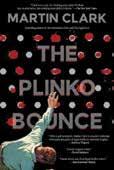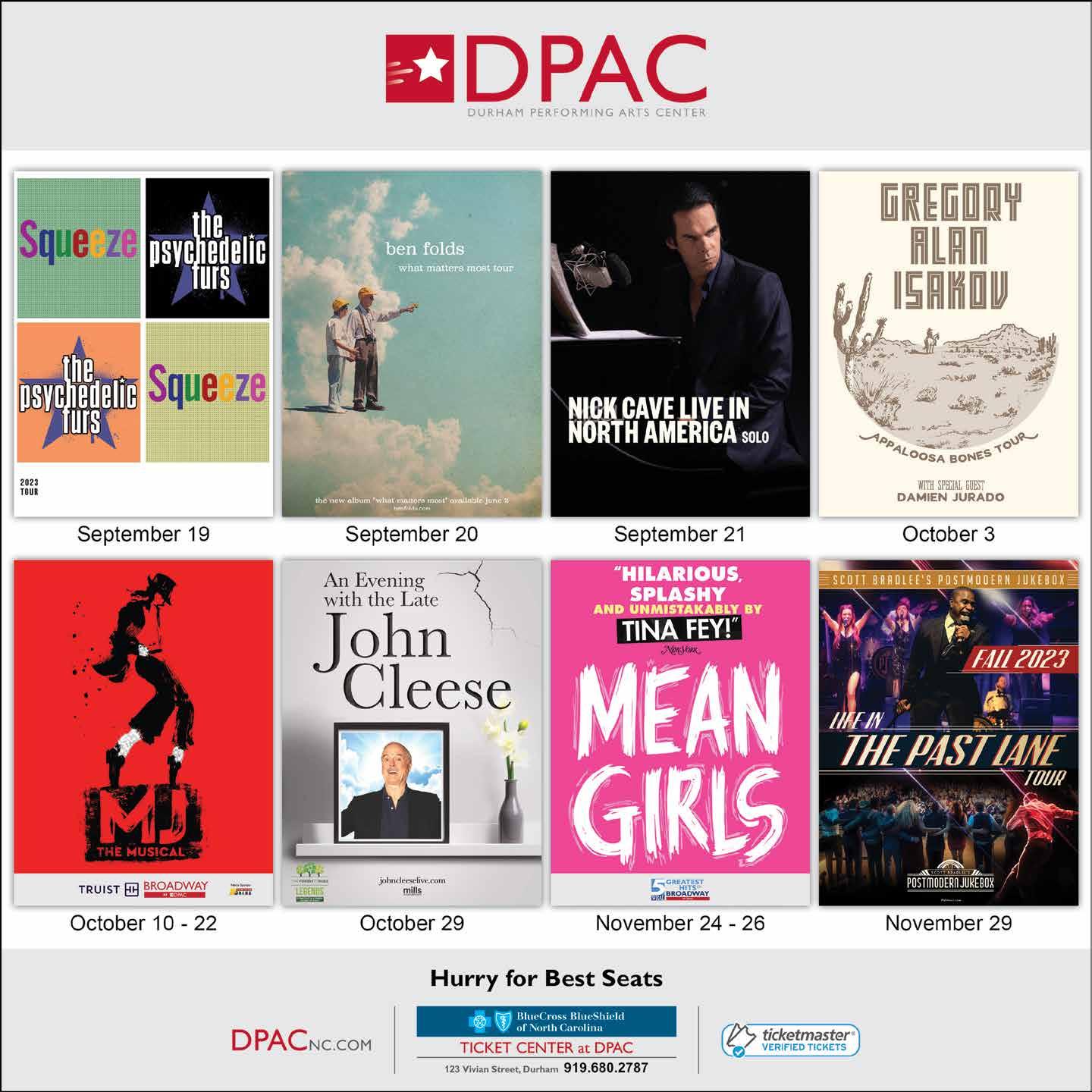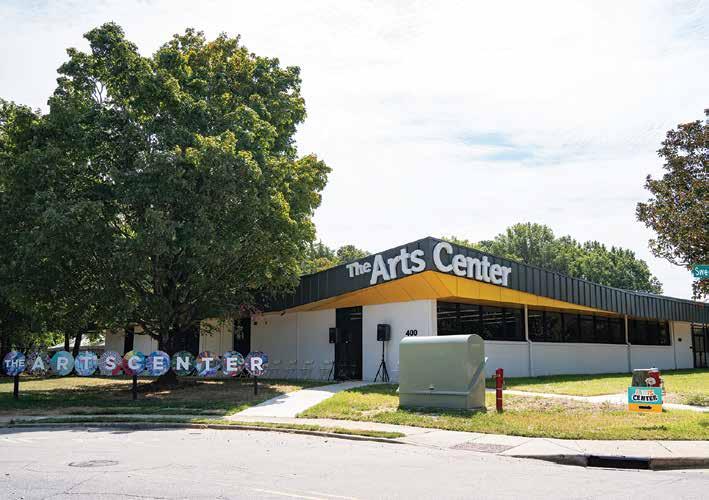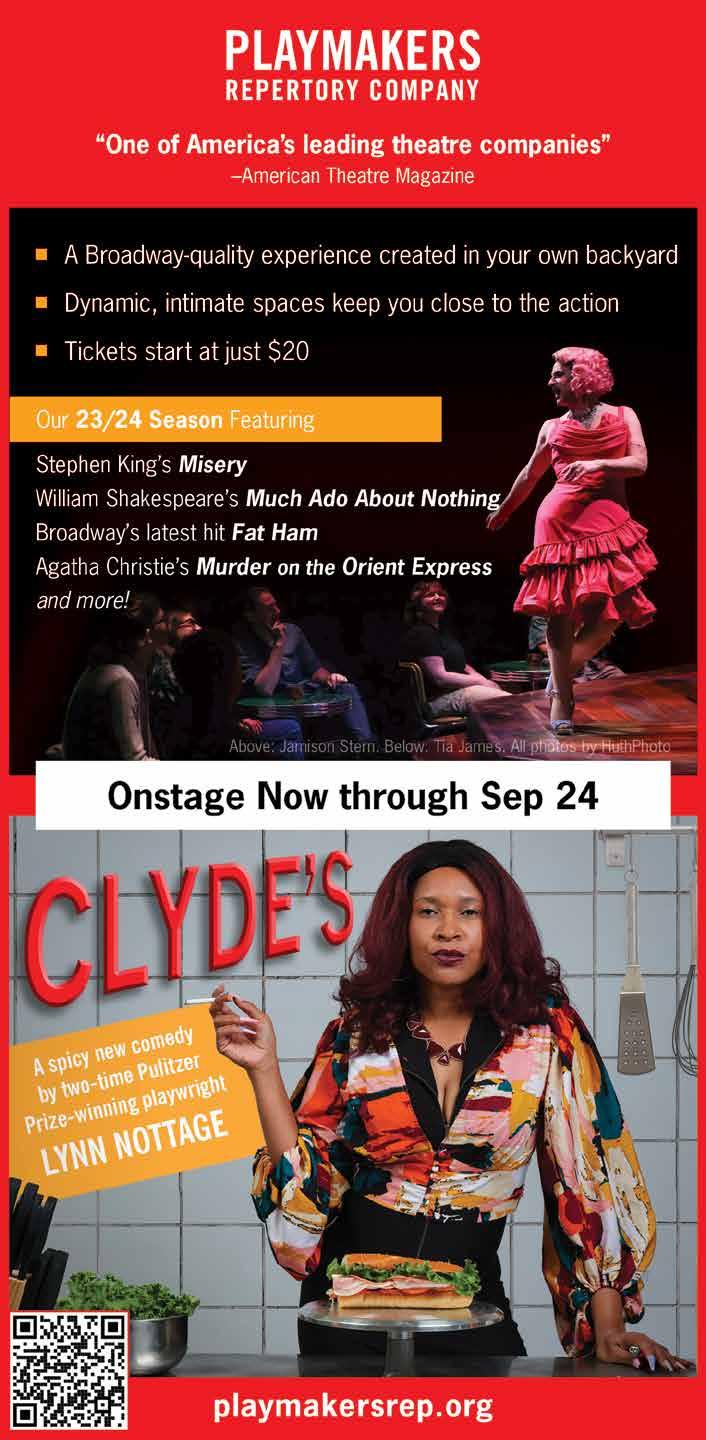THE DREAM KEEPERS




In downtown Durham, a new fine-arts gallery (by sarah edwards, p.34) and jazz venue (by kyesha jennings, p.18) carry on the legacy of Black Wall Street and usher in a new era for the arts.


NEW THEATER, MUSIC, AND EXHIBITIONS TO CATCH THIS FALL








 Raleigh | Durham | Chapel Hill September 6, 2023
Raleigh | Durham | Chapel Hill September 6, 2023
Raleigh Durham Chapel Hill
VOL.
CONTENTS
6 As Wake leaders work to prevent displacement due to rent hikes, Grosvenor Gardens residents are on the brink of losing their homes. BY JASMINE
 GALLUP
GALLUP
9 How will Durham's housing crisis and SCAD's attempt to address it impact the upcoming election?
BY MATT HARTMAN
ARTS & CULTURE
18 Cicely Mitchell's new jazz venue will be an ambitious new social hub for downtown Durham. BY KYESHA
JENNINGS
25 On his most boisterous record in years, M.C. Taylor finds new rhythm as Hiss Golden Messenger. BY JORDAN
LAWRENCE
27 Albums reviews: No One Mind, The Connells, and Nightblooms.
BY BRIAN HOWE AND JORDAN LAWRENCE
30 The new ArtsCenter opens—and an emerging theater company finds a new home in the center's former space. BY BYRON
WOODS
32 This fall's must-see theater across the Triangle. BY BYRON
WOODS
34 Linda Shropshire's Ella West Gallery carries on the legacy of Black Wall Street.
SARAH EDWARDS
36 This fall's must-see arts exhibitions across the Triangle, this fall
BY TASSO HARTZOG, SARAH EDWARDS, AND LENA GELLER
THE REGULARS
3 Backtalk
4 15 Minutes
5 Voices
38 Culture calendar
COVER: Linda Shropshire, owner of Ella West Gallery, and Cicely Mitchell, owner of Missy Lane's Assembly Room.
PHOTO BY ANGELICA EDWARDS
WE MADE THIS
PUBLISHER
John Hurld
EDITORIAL
Editor in Chief
Jane Porter
Culture Editor
Sarah Edwards
Staff Writers
Jasmine Gallup
Lena Geller
Contributors
Spencer Griffith, Carr Harkrader, Matt Hartman, Brian Howe, Kyesha Jennings, Jordan Lawrence, Glenn McDonald, Thomasi McDonald, Nick McGregor, Gabi Mendick, Shelbi Polk, Dan Ruccia, Harris Wheless, Byron Woods, Barry Yeoman
Copy Editor
Iza Wojciechowska
Interns
Mariana Fabian, Hannah
Kaufman, Iris Miller
CREATIVE
Creative Director
Nicole Pajor Moore
Graphic Designer
Izzel Flores
Staff Photographer
Brett Villena
ADVERTISING
Publisher
John Hurld
Director of Revenue
Mathias Marchington
CIRCULATION
Berry Media Group
MEMBERSHIP/ SUBSCRIPTIONS
John Hurld
Carolina Ballet performs Firebird at Martin Marietta Center for the Performing Arts from September 14 to October 1

INDY Week | indyweek.com P.O. Box 1772 • Durham, N.C. 27702 919-666-7229
EMAIL ADDRESSES first initial[no space]last name@indyweek.com
ADVERTISING SALES advertising@indyweek.com 919-666-7229
Contents © 2023 ZM INDY, LLC
All rights reserved. Material may not be reproduced without permission.
2 September 6, 2023 INDYweek.com
NEWS
40 NO. 28
PHOTO COURTESY OF CAROLINA BALLET
in DY 2023 FALL A rt S PR evie W
B A C K T A L K
Two weeks ago, we published the second installment in a four-part series from writer Matt Hartman on Durham’s upcoming municipal election. The story focused on the issues of crime, policing, and public safety and the impact those issues have had in the years past versus how much they’re on Durham voters’ minds today. Our readers had thoughts.
From reader STEPHEN KNILL, via email:
First, I am a supporter of well designed, measurable community programs that go beyond traditional police work. I am also a supporter of making sure our police force understands we value what they do to keep us safe and compensate them accordingly in a highly competitive market.
The most interesting and disappointing thing about the HEART program (and Shot Spotter for that matter) is that it shows no tangible results from 2022’s efforts in the reports that helped get them an $8MM increase in funding.
No direct reports on anything they actually did at the events they participated in, what their role was, or any results, either short term or long term. I’ve not found any qualitative data even telling the story of one stop and any success associated with it. If someone has one, please share.
This seems to be yet another City and/or County program where goals and results are tailored to what was done after the fact to show success rather than laying out tangible measurable objectives upfront and then reviewing them prior to approving or renewing to determining how the individual program will go forward (or not).
The city and the county are both businesses (look at their budget!) and need to operate that way.
And from reader FRED S. NAIDEN, a
professor emeritus at UNC-Chapel Hill, via email:
The second installment of this useful series stops just short of asking several questions. As this article says, having more police or more social services requires more tax revenue for the City of Durham, and those paying this additional revenue will be newly arriving urban professionals and their employers—in a word, the agents of gentrification. How will Black Durham leaders with either Duke or NC Central degrees respond? Some of these leaders have very vocally opposed gentrification. Others have been less vocal, if not silent. Some have spoken of “development” and not “gentrification,” but these phenomena overlap.
Poor Black and Brown tenants often find that “development” leads to eviction. How much work are leaders doing to help the Democrats gain control Raleigh and change the laws for landlords and tenants so that eviction becomes less common? Other questions are for those leaders who in the past have proposed abolishing the Durham police. What public-safety policy will help the Democrats in Raleigh? Abolition of the state police? Community control of city police, as in Chicago? Other nostrums?
Check out the third installment in Hartman’s series taking a look at the impact of housing, development, and SCAD in Durham—and how those issues could affect the upcoming election—on page 9 of our paper this week.
INDYweek.com September 6, 2023 3 Vote for your favorite Orange or Chatham County bar, veterinarian, bookshop, museum—whatever it may be, there are over 100 categories in which you can profess your favorite Orange and Chatham County treasures. Later in the year we will vote among the winners from all participating regions to determine the Best of the Triangle for 2023! The most recognized award throughout the Triangle is back for 2023— NEXT UP ARE ORANGE AND CHATHAM COUNTIES! VOTE.INDYWEEK.COM VOTE NOW! Orange & Chatham Counties FINALIST BALLOT LIVE Best Triangle 2023 of the Orange & Chatham Counties
WANT TO SEE YOUR NAME IN BOLD? indyweek.com backtalk@indyweek.com @INDYWeekNC @indyweek
Durham
15 MINUTES
Leo Egger
Founding artistic director of the Eno River Players who directed and orchestrated a tour of Dead Souls this summer
 BY HANNAH KAUFMAN backtalk@indyweek.com
BY HANNAH KAUFMAN backtalk@indyweek.com
You started Eno River Players at age 14. What inspired that?
I loved Shakespeare from a young age because my dad had introduced me and my twin brother to [his work]. [When I was 14] I wanted to do a production of Hamlet, and so I founded this community theater, the Eno River Players, and we did the first show with adults and students from Durham School of the Arts, where I went. We did the show at the Mosaic Church of Durham, on Club Boulevard, in 2016. From there we did a bunch more shows. We built a community of artists who are excited about doing classical theater, which is what I love, especially finding a way to make classical theater be text driven and also really new—and therefore accessible to new audiences, pushing people’s expectations of what they can see. I did that, and we did a few other shows. Then I went off to college, where I’ve been doing classical theater still, but recently I’ve been doing some Russian theater. And then this summer, with some friends of mine from Yale, we decided to put together a little tour of this play, Dead Souls, and we thought it’d be great to use the resources of the Eno River Players, use our name here and
the resources we have from our previous shows, and just start here in Durham.
How did Dead Souls tie into the Eno River Players?
Eno River Players is my theater company, so I guess [Dead Souls] is under the umbrella of the Eno River Players because it fits within our mission. We’re serving theater here in Durham, which is a really important thing and something that’s really lacking in our community—community-based, interesting classical theater—so I was hoping we could give something to Durham by doing this premiere here.
I was studying Russian theater and I had a professor named David Chambers at Yale, and I was really interested in [the Russian novelist Nikolai] Gogol—I had done a production of The Government Inspector, the very famous full play that Gogol wrote, and then [Chambers] told me about this Dead Souls play. [My professor knew] a translator who did the first English translation of it, and I was interested in doing a production of it, and he said we could
use it for free, which was incredibly generous. And then I got a little team together of only three actors.
What was your plan for having three actors playing 30+ characters?
The version we’re presenting is a slightly edited version of the original script, because we’re trying to build it in such a way that it can work for three actors to play multiple parts. I was excited because the whole play is about the artistic process, but this play is framed as Gogol writing the [novel], constructing it, and in that way it works with the vision that’s expressly imaginary and has elements of make-believe. You’re trusting the audience to use their imagination, you’re saying, “Hey, this is an imaginary world we’re building, this is the world from the mind of an author, and now you’re going to have to imagine these three actors playing all these different characters. We’re going to help you with basic, theatrical information like props and costumes. But your job is to use your imagination—that’s why you come to the theater.”
What reflection did you hope the audience would be left with?
The vision of so much of my work is to show what is unique about the theater as an art form and how it can create a sense of shared seeing between audiences and actors, that we can enter a space of imagination and make-believe together. That comes from experimenting with and using the form in a way that is unique to it. On a larger level, the play has its own message, too: it’s a play about avarice, greed, and about the way in which elite society destroys the dignity of the individual. This play is so interesting because that’s expressed through comedy, satire, and absurdity. But underlying that is real tragedy, about the way that we treat one another, that destroys [one’s] humanity. And then it’s also about how an artist restores that humanity, which in this case is about Gogol creating this work of art, kind of an exceptional thing. Or, even on a meta level, Bulgakov writing [the first stage adaptation of Dead Souls]—he [was a writer] during the Stalin era in Russia, and was begging Stalin to let him leave Russia—and then this is his first work after that. So the thing that captures my imagination the most is about the responsibility of the artist.
How did you feel approaching this summer’s tour, from Durham to New York to London?
I’m so grateful that we got to start here [in Durham], and that we got to kind of do it on a less high-pressure level here and could enjoy that before moving on. W This interview has been edited for length and clarity.
4 September 6, 2023 INDYweek.com
Leo Egger PHOTO BY JOJI BARATELLI
The American Nightmare
The shooting at UNC last week is yet another terrifying reminder of the violence that can intrude into the spaces that are supposed
BY SARA PEQUEÑO backtalk@indyweek.com
There was a killing last week at my alma mater. It was the second week of classes.
There were students who flew across oceans, over the heartland, and up the Atlantic. The majority of them drove in from across the state. All of them sought something: an education, salvation from their hometowns, or the great perhaps promised to them by the American Dream.
Thousands of them, mostly 18-to-22year-olds, spent the afternoon locked in classrooms, frantically trying to keep in touch with the people who had just kissed their children goodbye. Schoolchildren in the surrounding town were doing the same. Instructors frantically searched for updates as the university, its people, and its buildings stayed silent and still, save for the area around the laboratory with a bullet hole in its window pane.
The hours spent hiding were what these students, almost exclusively Gen Z, have been training for their whole lives. We are the generation that Columbine bore, and whose unofficial end year coincided with the mass murder of kindergarteners at Sandy Hook Elementary School. They know not to expect anything to change.
We are the generation that has grown up practicing what to do if someone enters your school with a gun. We pulled our knees to our chests on the floor behind bookcases and under desks, perfecting the practice of making your body as small as possible. We were critiqued afterward, based on our ability to stay quiet. “If this was real you’d all be dead,” one of my teachers told a class after a drill.
We are the ones who were told what to do if we ever found ourselves in a classroom with a man holding a semiautomatic assault rifle. At age 13, a lock-

down delayed the start of my eighth grade graduation. At 15, I learned through social media that covering yourself in another’s blood and playing dead could protect you after the initial carnage, lest the shooter return to finish the job.
A man walked into a laboratory at my alma mater and shot someone to death, and I wish I was able to grieve. I wish I could feel anything but dread, knowing how the rest of this plays out, knowing that people will forget, that even people in neighboring cities are going about their lives now. The college students didn’t even get the week off.
This lack of feeling would be more tolerable if I could channel the calm, half-joking demeanor of my high school teachers in rural North Carolina, who either owned guns or knew people who did. They remained stoic in our classrooms as alien school names cycled in and out of the cable news cycle. It would be more tolerable if I could accept any more “thoughts and prayers,” if I didn’t have to consider the racist conspiracy theories about the reason behind the killing—including from powerful Republicans in my home state.
The man charged in the killing was a physics PhD student. The dead, Dr. Zijie Yan, was his professor.
Yan was described as a “beautiful person” with “a resting sweet face” in The News & Observer by the people who knew him. He was a Chinese immigrant who began learning English as a student at Rensselaer Polytechnic Institute, where he coauthored at least 17 papers. He had students working under him and was supposed to teach an undergraduate class this fall. He had two children and lived in a suburb between Chapel Hill and Raleigh.
Yan came to this country for the same reason students come to UNC-Chapel Hill. In many ways, he was able to achieve the American Dream. His family will never be so lucky. His children will never be able to shake the way their lives were altered on the first day of school.
The rest of us are still stuck in the American Nightmare, the only way to describe the constant threat of violence fueled by too many guns and not enough mental health care. Carolina joins dozens of universities that have been changed forever by gun violence—and they aren’t even through the first month of classes. W
Sara Pequeño is a former INDY staff writer and current freelance writer based in New York City.

INDYweek.com September 6, 2023 5
to be safe.
VOIC E S
Sara Pequeño
PHOTO BY JADE WILSON
Forced Out
Wake County leaders are trying to prevent displacement due to rent hikes, but their efforts haven’t helped Grosvenor Gardens residents, who are on the brink of losing their homes.
BY JASMINE GALLUP jgallup@indyweek.com
Felix Watson was working their regular shift at Starbucks when they received some of the worst news of their life: rent at their studio apartment in Grosvenor Gardens was increasing from $845 per month to $1,100 per month.
For weeks, Watson had dreaded receiving a letter from their apartment complex. Rent had already gone up by about $50 in the months before, a foreboding signal of things to come. Now, an alert was pinging on Watson’s phone that the news they’d feared had arrived.
“I burst into tears,” Watson says. “I thought, ‘I am being forced out of my home. I am going to be forced back into an unsafe living situation with people who could hurt me. I am not going to be able to afford to live.’”
The 29-year-old barista trainer has a history of struggling with depression, and the news sent them into a downward spiral.
“I was extremely suicidal for about a month,” Watson says. “[I thought], ‘I don’t want to exist if I don’t have a
home.’ My friends and coworkers have had to spend the past couple of months talking me down.”
Today, Watson’s mental health is better, but their situation is unchanged. Rent is still set to increase for most residents to $1,100 per month, following affordable housing nonprofit CASA’s purchase of Grosvenor Gardens. The Raleigh nonprofit bought the property last year in an effort to keep it affordable, with help from Wake County’s Affordable Housing Preservation Fund.
Even with the loan, however, CASA has a large mortgage to pay off, a consequence of the Triangle’s uber-competitive housing market. Ultimately, the organization is thankful it could prevent the historic building located on Hillsborough Street from being demolished, according to a statement from Emma Hansen Doss, CASA’s director of mission advancement.
“This building and its nearly 100-year-old gardens are a Raleigh Historic Landmark in a highly desirable location
that was at risk of being torn down,” Doss wrote. “CASA is proud to have prevented this naturally occurring affordable housing from disappearing and is committed to the best possible outcome for every single person.”
Since news broke of the rent hikes, CASA has reached out to some residents, particularly those making at or below 50 percent of the area median income (AMI), like Watson. For people earning less than 30 percent AMI, rent hikes were canceled.
For Watson and others, rent hikes were delayed until November. In the past few months, CASA has also given residents applications for other CASA properties with lower rents. CASA offered additional help in the form of “financial assistance, applications for [federal] Housing Choice Vouchers, [and] a list of community resources for additional rental assistance,” Doss wrote.
But for Watson, none of that has made a significant difference.
Moving out
As Watson started a desperate search for another place to live, they had to put aside other priorities in life, like focusing on work or going back to college. Watson had planned to return to school through Starbucks’s education program, but “I can’t get my life together when [my landlord] is screwing me like this,” they say.
Of course, Watson isn’t the only one struggling. Since news of the rent hike broke earlier this year, several Grosvenor Gardens residents have already moved out, such as 27-year-old Alyssa Fisher, who wrestled for months with the decision. Fisher’s Grosvenor Gardens studio isn’t that great, she says, but she appreciated the independence.

Now, “I can’t afford this $1,100,” Fisher says. “While my income says I might be able to, maybe it’s 30 percent of my area median income, I can’t do it. I’m paying off student loans, I’m paying off credit card debt. I don’t have the extra $255 a month.”
After getting the news, Fisher looked for an apartment in Raleigh but couldn’t find anything in her budget.
“At first I was looking to see if I could sublease a place [but] there’s nothing for sublease,” she says. “There’s nothing under $1,100 in Raleigh.”
Eventually, Fisher and her partner decided to move in together. Today, the only way either of them can afford to live in Raleigh is by creating a double-income household. But that’s not an option for Watson. The Raleighite says they have had some bad experiences with roommates in the past, even friends, which make them reluctant to risk sharing an apartment again.
Watson is looking into affordable housing communities that serve people making less than 50 percent AMI, but many have waiting lists up to a year long. Even if Watson
6 September 6, 2023 INDYweek.com N E W S Raleigh
Alyssa Fisher photographed across the hall from her former apartment at Grosvenor Gardens
PHOTO BY ANGELICA EDWARDS
























INDYweek.com September 6, 2023 7 ON YOUR INSTALLATION 50% OFF Limited Time Offer! SAVE! TAKE AN ADDITIONAL Additional savings for military, health workers and first responders 10% OFF New orders only. Does not include material costs. Cannot be combined with any other offer. Minimum purchase required. Other restrictions may apply. This is an advertisement placed on behalf of Erie Construction Mid-West, Inc (“Erie”). Offer terms and conditions may apply and the offer may not available in your area. If you call the number provided, you consent to being contacted by telephone, SMS text message, email, pre-recorded messages by Erie or its affiliates and service providers using automated technologies notwithstanding if you are on a DO NOT CALL list or register. Please review our Privacy Policy and Terms of Use on homeservicescompliance.com. All rights reserved. License numbers available at eriemetalroofs. com/erie-licenses/. NC License Number: 83195. MADE IN THE U.S.A. 1.844.967.1863 FREE ESTIMATE Expires 9/30/2023 Before After Make the smart and ONLY CHOICE when tackling your roof!
does find an apartment, they’re scared their rent will go up again.
“What if this just keeps happening?” they ask. “Even five years ago, I never thought this is what somebody would be trying to charge for a studio apartment of this quality.”
Public housing is an even worse option, Watson says, with a waiting list of two to seven years. Even then, you have to constantly update the housing authority on your income and place of residence, “or they will kick you off the list and you will go back to square one,” Watson says.
Watson considered moving out of the city to a moderately less expensive Triangle area like Durham, Chapel Hill, or Carrboro, but the move could risk their job. If they end up having to transfer to a different Starbucks location, Watson could end up with fewer hours or worse tips, they say. Their last resort is moving back in with their family in Wisconsin. But, Watson says, “I have a life here. I work full-time and I manage my money well. I think I should be able to afford a place to live.”
How much is an apartment worth?
Like many other Grosvenor Gardens residents, Watson has had some issues with their apartment over the years, before CASA purchased the complex. But rent was so much lower than at any other complex, they were willing to overlook it.

“It’s kind of a run-down building,” Watson says. “But the rent was $795 when I moved in, and that was cheaper than most other things in the area.”
Fisher, who has lived at Grosvenor Gardens for about three years, says her neighbors have had to deal with everything from cockroaches crawling across the floor to leaking pipes. Safety is a concern too, since some windows don’t lock and the surrounding area is dimly lit, Fisher says. “This place hasn’t been maintained super well, and a lot
of us were kind of willing to look the other way because we have such low rent,” says Fisher. “[But] if you’re going to charge $1,100 for this [studio], it needs to be updated.”
Since purchasing the building last November, CASA has “invested in long overdue building repairs and necessary safety updates,” wrote Doss. Fisher, however, says she hasn’t yet seen significant improvements. In May, a fire broke out in her neighbor’s apartment. The incident left her entire apartment smoke-damaged and unlivable for weeks.
Without anywhere to go, Fisher jumped from couch to couch. After appealing to CASA for help, she was finally moved to a vacant unit elsewhere in the complex—but that came with its own issues.
The apartment was dirty and infested with bugs, Fisher says. She kept asking when her original studio would be fixed, and was put off. She reached out to everyone she thought could help: management company employees, CASA employees, even the CEO. But no repairs were made.
Finally, at the end of June, a restoration company came to fix Fisher’s apartment. She moved back in, but couldn’t re-settle. Her hallway was still damaged from the fire. Water started running down her walls from her upstairs neighbor’s shower.
“I’ve gone down every avenue,” Fisher says. “I’ve talked to the management company, I’ve talked to the people at CASA …. I’ve called Raleigh Code Enforcement. Those things are supposed to be helping me, [but] everybody is just playing hot potato.”
A broken system
As a month-to-month renter, Fisher doesn’t have much recourse. She has few rights in North Carolina compared to her landlord, and even fewer housing options in today’s market.

Since 2019, Wake County has funded the construction or
preservation of 3,568 affordable apartments and 21 affordable homes, according to Mark Perlman, a division director in the Wake County Housing Department. About 1,602 (or 45 percent) target renters who make at or below 50 percent AMI. For one person, that’s less than $39,700 per year.
Growth in Raleigh is so rapid, however, that the county’s many loan, subsidy, and construction programs have only made a small dent in the problem.
The county is trying to create as many “very low-income-targeting units as we can, with the resources we have available,” says Perlman. The problem is that money only goes so far. If you charge less rent, you can’t build as many apartments. If you build more apartments, you have to charge more rent.
“We are trying to create units to accommodate those renters [who make 50 percent AMI or below],” Perlman says. “The Raleigh Housing Authority is trying to expand the availability of resources as well, as far as rental supports.
“We are absolutely sympathetic to the situation that these renters are in. We recognize that the stock of rental units that these workers can afford is dwindling, and so we’re trying to keep up.”
Doss echoed Perlman, writing that “the entire team at CASA understands and empathizes with the residents at Grosvenor Gardens.”
“We will continue to work around the clock to find solutions that are impactful and lasting for the community we serve,” she added.
Grosvenor Gardens residents, though, are angry. Watson and others feel that the efforts of CASA and Wake County leaders to keep them in their homes have failed. CASA may be keeping Grosvenor Gardens affordable for hypothetical future residents, but it’s become out of reach for 22 current, low-income residents, all of whom need a place to live.
“They’re straight gaslighting us,” Watson says bitterly. “They’re trying to make us feel good about hurting us because they’re not hurting us worse.” W
8 September 6, 2023 INDYweek.com
Grosvenor Gardens Aparments, a historic complex built in 1935, is home to about 62 residents, 22 of whom are low-income PHOTO BY ANGELICA EDWARDS
Felix Watson photographed in their Grosvenor Gardens apartment PHOTO BY ANGELICA EDWARDS
Part 3: At Home with the Matadors
How will Durham’s housing crisis and SCAD’s attempt to address it impact the upcoming election?
BY MATT HARTMAN backtalk@indyweek.com
Jerry McClain’s house is the one on Fayetteville Street with the skeletons hanging in effigy and a sign reading, “Black seniors hung out to dry and die.”
He’s been accumulating protest signs for years, since the city began negotiating to buy part of McClain’s property in 2013.
After construction on the intersection of Fayetteville Street and Riddle Road started in 2019, the city realized it needed more of McClain’s land than expected. Negotiations failed. The skeletons came sometime after that.
McClain’s case was on the agenda for the August 21 Durham City Council meeting, but it got little attention. The crowd that had packed the council chambers was there for a different debate about development, equity, and change: SCAD.
Short for “Simplifying Codes for Affordable Development,” the proposed amendments to Durham’s unified development ordinance (UDO)—the collected zoning regulations that determine what can be built, and where, in the city—has become Durham’s most explosive political issue.
Shortly after the meeting began, and quickly devolved into accusatory mudslinging, SCAD’s applicant, the Raleigh-based developer Jim Anthony, requested a 90-day delay, pushing the vote until November.
It was a tacit acknowledgment that SCAD had become too controversial for election season.
SCAD first came before the council in March, but this
latest delay spurred Mayor Elaine O’Neal to suggest “a different kind of task force” that could draw on nearby universities for objective analysis. “I think that’s part of the missing discourse,” she said. “There is not an objective voice.”
This week, the task force is supposed to present a plan on how to proceed.
Durham is quite literally being remade. You don’t have to believe in the housing theory of everything—the idea that rising property costs exacerbate issues ranging from income inequality to climate change—to see how the council’s development decisions are shaping the city’s future.
Even at their best, those debates are split into binaries—affordable housing activists versus developers, NIMBYs versus YIMBYs—that are inadequate for the task. But the confusion and vitriol of the August meeting show just how poorly equipped Durham is to navigate questions of its future in its current political state.
Poor Black neighborhoods have allied with wealthier white homeowners against accelerating construction, while some of Durham’s progressives and business-friendly moderates have joined forces with local urbanist developers in the hopes of making the most of the city’s limited powers. All are caught in a stranglehold by the General Assembly.
The vast majority of voters are trying to make sense of it all. Tenants, especially, are just trying to pay their ever-increasing rent.
Method in the madness
Nearly everyone in the debate agrees on two things: rising housing costs are creating a crisis in Durham, and the city’s zoning regulations should be overhauled. The statistics paint a stark picture of the problem’s scale. Out of roughly 122,000 households in Durham, nearly 39,000 can’t afford their current living situation. The Durham Housing Authority (DHA), long starved of resources by the federal government, has a 3,500-person waitlist for one of the 1,700 units DHA controls and an 8,000-person waitlist for the housing vouchers tenants can use on the private market, according to DataWorks NC.
Nonprofit affordable housing developers are attempting to fill the gap, but they’re a drop in the bucket. Durham’s largest nonprofit homebuilder, Habitat for Humanity, built just 17 homes last year. Each costs $170,000, meaning that if Durham donated its entire 2024 city budget to Habitat, there would still be more than 35,000 housing-burdened people.
Private developers provide the vast majority of affordable housing in the United States, so the only solution is to use the law to regulate more affordable housing. But North Carolina doesn’t give local governments the powers that other cities around the country use.
Rent control is illegal in privately owned apartments (with a few important exceptions), as is mandating that

INDYweek.com September 6, 2023 9 N E W S Durham
PHOTOS VIA PEXELS AND UNSPLASH. ILLUSTRATION BY NICOLE PAJOR MOORE
private developers provide affordable housing. Progressive taxes are an obvious source to boost revenues that could fund projects, but the state constitution prevents cities from instituting them. Local minimum wage laws are forbidden, too, so there’s no direct route to boosting flagging incomes. Tenants don’t have the right to withhold rent when their apartments aren’t up to code unless they obtain a court order.
But cities can create zoning codes. By limiting what can be built where, codes shape the economics of development. Done right, they can weigh the scale and tilt projects in certain directions.
By only allowing houses less than 1,200 square feet in specific areas, for instance, zoning regulations can prevent new McMansion developments. And by creatively writing regulations, the city can provide incentives that entice developers to build affordable housing—say by letting them build taller than they could otherwise if they voluntarily agree to set some percentage of the units aside for low-income residents.
But those strategies must be precisely calibrated to current economic conditions to work, and Durham’s UDO was written 20 years ago.
Technical tweaks and big dreams
Growing frustrated with the situation, several local developers, builders, architects, and other practitioners began the process that gave birth to SCAD.
On a drive through Old West Durham in mid-August, developer Aaron Lubeck pointed to a former church for sale next to Locopops and Cocoa Cinnamon. A large, empty parking lot sits between it and Hillsborough Road. Because the current UDO requires buildings to have a certain amount of parking spots, the lot couldn’t be developed separately from the church, Lubeck explains.
“You’re on a corner that already has two of the four corners with great little businesses,” he says. “This would be a great parcel to build something, whether it’s housing or commercial space or whatever. But it’s locked.”
Because of such restrictions, Lubeck says the market for local affordable housing builders is nonexistent today.
“The only thing that’s getting built is 100 percent outof-town money, 100 percent big projects that are political and require lawyers and compliance officers and the kinds of things nobody local could do,” he says.
Taking advantage of a Durham process that allows private citizens to propose amendments to the UDO for a $4,396 fee, SCAD’s authors put together a list of changes that would support the small-scale projects that larger national developers don’t bother with. They focused on the lots remaining around Durham’s urban core that are too small, weird, or complicated to have been built already.
A proponent of the new urbanist movement that advocates for walkable cities with residential and commercial
spaces intermixed, Lubeck was particularly interested in the way the UDO’s minutiae—buffers, setbacks, water runoff standards, and the like—create dead, car-centric space.
Buildings have to be too far apart with too much parking, Lubeck says. Driveway requirements mean they can’t position houses in the most rational way on some lots. Neighborhood corner stores aren’t feasible because of rules preventing commercial development in residential areas.
“There are all these opportunities to build relatively short urbanism, and that includes office space, housing, restaurants, and allows that kind of organic messiness that people love about Durham but we’ve truly legislated out of existence,” Lubeck says. “We have a lot of sprawl repair to do and a lot of infill on that front, and that would be transformative.”
SCAD even put a 20,000-square-foot maximum on some provisions—a limit Lubeck says was specifically chosen to prevent dollar stores from using them.
Those small projects are technically possible now, but they require developers to get approval for special permits and rezonings. Because those approvals require studies, site plans, drawings, and other services before they are voted on, and the lawyers, engineers, and other
There goes the neighborhood
For many residents in the majority Black neighborhoods already experiencing rapid gentrification, Lubeck’s dream sounds more like a nightmare that will make housing more expensive, not less.
Their argument is simple: look around. “How’s that worked over the past 15 years?” asks city council member and mayoral candidate DeDreana Freeman.
SCAD’s most controversial provision has compounded the skepticism. Progressing Affordably Towards Housing (PATH) would alter the city’s affordable housing density bonuses—the carrots used to entice builders to guarantee cheaper housing.
The amendments would increase the percentage of units that have to be made affordable from 15 to 25 but reduce the length of time they have to remain affordable. From the current 30-year requirement, it would drop to just five for rentals. For-sale units would revert to market rate immediately after their original sale.
“That does so little to address Durham’s problem,” Bonita Green, president of the InterNeighborhood Council (INC) and a city council candidate, wrote in a March email to the council. “It is shocking given how advocates emphasize this benefit in presentations.” (Disclosure: Green and I both serve as DataWorks NC board members.)
Lubeck argues that even the reduced time frames are better than what we have now. But that has done little to convince skeptics.
“There’s no oversight, so they’re creating problems for others,” Green says. “It’s intentional as well by these developers, because they’re trying to push these people out because they want the land.”
specialists often attend the various hearings, Lubeck says developers have substantial costs before a vote that could still end in rejection. He estimates an average cost of $50,000 for projects impacted by SCAD, but says $150,000 isn’t uncommon. The risk is too great for small developers, making it more likely that the city gets uglier, more expensive projects from large national and international investors.
While many of SCAD’s 130 proposed UDO changes are small tweaks, like determining how close small stoops can be to the street and which yard in strangely shaped lots counts as the rear yard, there are also significant shifts.
It would eliminate regulations requiring a minimum amount of parking spots for any new development. Any planned developments with more than 100 housing units would also have to set aside space for civic or commercial purposes, pointing toward walkable developments. And SCAD would allow faith-based institutions to develop housing projects on their land—a provision Lubeck says would be the most impactful, given the vast amount of land they own.
Instead of relaxing standards—an approach INC has chastised as “trickle-down housing”—critics like Green want to see the city take a more aggressive approach to developers. That means restricting what can be built unless substantial affordable housing concessions are made, since zoning is the only real leverage the city has.
“Real estate is about dealmaking,” says planning commissioner, city council candidate, and SCAD opponent Nate Baker. “The other side writes books called Art of the Deal, and they want our side to think we have to accept the first deal that comes to us on the table.”
The working-class Black community of Bragtown is a case in point. After the Bragtown Community Association effectively defeated a proposed 900-home development with only 20 affordable units, a new developer arrived and offered 325 affordable units instead.
Ultimately, Green’s goal is to ensure that marginalized communities benefit from whatever development happens, which is why she objects when the SCAD opposition is characterized as NIMBYs who simply don’t want new projects.
“That’s not true,” she says. “People don’t mind building.
10 September 6, 2023 INDYweek.com
“The only thing that’s getting built is 100 percent out-of-town money.”










INDYweek.com September 6, 2023 11
Raleigh's Community Bookstore
Vanessa Miller, The Light on Halsey Street
Martin Clark, The Plinko Bounce
Craig Johnson, The Longmire Defense
EVENTS Get tickets to these events and others at www.quailridgebooks.com www.quailridgebooks.com 919.828.1588 • North Hills 4209-100 Lassiter Mill Road, Raleigh, NC 27609 FREE Media Mail shipping on U.S. orders over $50 IN-STORE IN-STORE IN-STORE IN-STORE FRI 9.15 7:00 PM THU 9.7 7:00 PM SAT 9.16 10:30 AM TUE 9.19 7:00 PM
Donna Washington, Prak Fills the House
It’s the way that it’s done. You’re pushing out our voices. We don’t have a say-so in this, and we don’t like the way that you’re building.”
Jim Anthony’s role as the amendments’ figurehead hasn’t helped SCAD’s case. Notoriously right-wing, Anthony told INC that “gentrification is necessary to erase the ‘blight,’” according to an INC report on SCAD.
“I don’t think there’s anyone who has ever looked at our projects and would say, ‘That was a mistake’ or ‘That damaged anybody in this community,’” he said at the August council meeting, proving his ignorance of Durham public opinion.
Demanding supply
Given Anthony’s role, many Durham progressives are wondering why left-wing politicians are backing SCAD. Why choose Anthony over poor neighborhoods?
But SCAD’s supporters don’t disagree about the problem of gentrification. The proSCAD council bloc have all opposed PATH’s affordability periods. They back SCAD in general because they come to the opposite strategic conclusion when they see the impact of rich newcomers moving to Durham: more development, not less, is the only way to prevent the worst ills of that reality, they say.
Picture a typical, run-down Durham millhouse that could be sold today for $200,000 or $300,000. SCAD’s authors hope to make it possible to replace that one house with four new ones, which might go for $400,000 or $500,000 each. That’s a clear example of gentrification and an incentive for developers to displace more residents.
But SCAD’s backers are more worried about the alternative. If we don’t build those four houses, the argument goes, the original millhouse will still be flipped or torn down, except an $800,000 or $900,000 house will replace it. And the three households who would have built the additional houses on that lot will do the same somewhere else in the neighborhood.
“They’re going to make their money either way,” council member Javiera Caballero, who is running for reelection, says. “They’re going to put those big blocky things you all hate—those oversized crazy houses that everyone complains about. They’re going to build that, or they’re going to build more creative stuff.”
“Obviously a $350,000 townhome is insane,” council member Jillian Johnson says. “But that’s where we are now. It’s not about choosing between a utopian village and this developer’s proposal. We’re choosing between North Raleigh and the developer’s proposal.”
Precisely because the people moving to Durham—part of the fourth-fastest-growing region in the country—tend
to be wealthier, they’re able to bid up the price on whatever housing already exists.
“The African American community has taken to championing preserving some neighborhoods, not recognizing the spillover effect, as I call it,” says council member Mark-Anthony Middleton. “If a wealthy person has to move to our area, it’s not based on whether we build a house or not.”
That was the impact even with the bungalows in Southside, an affordable housing development in the historically Black neighborhood just outside of downtown.
An NC State University researcher found that despite controls limiting the sale of housing to low-income residents, the project’s beneficiaries were more likely to be white and rich than the neighborhood’s existing residents. One couple’s parents paid off their cars before they filled out the program application to ensure they would qualify. Accordingly, proponents of the supply-side strategy argue that the only viable option that can have an impact at scale is to build enough housing that vacancies increase
do is say no and hope the developer comes back with a better offer.
What’s a house for?
There’s one policy question that cuts across SCAD support and turns the debate into a confusing ideological muddle: the role of homeownership.
Moderate, entrepreneurial-minded SCAD backers like mayoral candidate Leo Williams and fervently anti-SCAD neighborhood organizers like Bonita Green share the goal of creating homeownership opportunities—as do many of the home builders who wrote the amendments.
“Everything is moving toward rentals,” Green says. “That’s the only way these banks make their money. If you’re not paying your rent, they can kick you out and charge a higher rent. And that’s problematic because people aren’t able to build wealth.”
Increasing the required affordability periods in PATH is essential to shrinking the racial wealth gap, Green and her allies say, because spurring Black homeownership is the goal. But the flip side is that affordability covenants cap how much wealth those houses can earn: someone who buys a house with a 30-year affordable covenant and sells it 10 years later doesn’t get to sell it for market rate, meaning their wealth doesn’t grow at the same rate as the rest of the city’s homeowners’.
“Why can we not have the ability to build wealth like white people do?” Camryn Smith, executive director of East Durham’s Communities in Partnership, says of those kinds of programs.
and prices begin to fall.
Some national data backs them up. New York writer Eric Levitz reports that places with the most new construction saw rents rise less than they did elsewhere. In places where the supply grew by more than 10 percent, rents even fell.
Though pushing back against projects in the hopes of more concessions might lead to better outcomes in cases like Bragtown, Johnson says it can also make things worse.
After tense arguments with both the Walltown Community Association and the normally affable former mayor Steve Schewel over the paucity of affordable housing in its plan to redevelop Northgate Mall, for example, new owner Northwood Ravin withdrew its proposal and replaced it with another, with no housing at all.
The city council still has a chance to weigh in when the project comes up for a rezoning request, but state law prevents it from explicitly requesting affordable housing as a condition for granting a zoning change. All they can
Arguing that there must be a “both/and” strategy to balance the number of affordable houses available while allowing their owners to profit from them, Smith unwittingly echoes the argument Williams makes in favor of SCAD.
“Who are we to get in the way of people building their wealth?” Williams asks. “You built your wealth this way. Why are you trying to block someone else?”
But homeownership has also been a driver of inequality. Though SCAD’s opponents compare the supply-side argument to Ronald Reagan’s trickle-down economics, it was white homeowners who launched the Reagan revolution in order to protect their property investment. With Durham’s median home value growing from roughly $186,000 in 2015 to $396,000 today, according to data from Zillow, Durham homeowners might have as much of a financial stake in the status quo as developers do in increasing construction.
Opposition to development in places like Bragtown may be understandable as a justified fear of gentrification, but there are plenty of SCAD critics whose interest lies in wealthy white neighborhoods.
12 September 6, 2023 INDYweek.com
“Obviously a $350,000 townhome is insane. But that’s where we are. It’s not about choosing between a utopian village and this developer’s proposal. We’re choosing between North Raleigh and the developer’s proposal.”


INDYweek.com September 6, 2023 13
Discussing the same Hillsborough Road intersection Lubeck saw as ripe for beautiful urban messiness, Tom Miller only saw an imposition on homeowners.
“When I was a little boy, this was a dirt street and those were houses,” the former planning commissioner and lawyer says. Pointing to the single-family homes that back up to the now commercial street, Miller laments how close SCAD would bring buildings to the existing houses.
“We create houses that are not desirable as residences, and we cause neighborhood decay,” he says.
“Dense living, if it’s too dense, in my opinion, works against the welfare of the body politic,” he adds.
There’s one group in particular that follows along with dense cities, whose existence is too volatile for Miller’s comfort: tenants.
“I was on the Planning Commission for seven and a half years. I don’t think I ever remember a tenants group coming in,” he says. “I don’t want more people in that unstable situation.”
SCAD opponent DeDreana Freeman tried another tactic to give tenants stability in 2021 when she proposed a tenants’ bill of rights in conjunction with the now defunct Bull City Tenants Union. But the project stalled out.
The city attorney’s office ruled out most of the union’s more ambitious demands, and the rest, Freeman says, would likely just lead landlords to raise their rents.
“The tenants’ bill of rights could be shifted into just a landlord agreement,” Freeman says. “They could voluntarily sign on to be a good landlord of the City of Durham with a stamp. But that would be as far as it would go until our General Assembly acknowledges that our tenants should have rights.”
But tenants bear the brunt of the housing crisis. They make up nearly half of Durham households, and 46.9 percent of them are housing-burdened, compared to just 17.5 percent of owners.
The progressives backing SCAD, like Johnson and Caballero, conclude that the best option available is using development powers to shift market conditions in a way that makes renting more affordable, even if it angers homeowners. After all, the evidence for the supply-side approach’s success is lower rents, not home prices.
That stance separates progressives from SCAD allies like Williams as much as it does SCAD’s opponents.
But there’s another kind of SCAD critic.
Baker, likely the first person to be endorsed by both the moderate Durham Committee on the Affairs of Black People and the Democratic Socialists of America, similarly argues for a vision of housing that isn’t based on the accumulation of wealth, though he says we must also close the racial wealth gap. (Disclosure: I am a member of DSA but played no role in the decision to endorse Baker.)
“I tend to view affordable housing, especially in an exploitative capitalist system, as a utility,” he says. “It’s a need we will always have—a utility like water pipes or
sewer pipes.”
That thinking is why his main complaint about SCAD is not that it builds too much but that it builds too little.
Baker’s goals sound similar to Lubeck’s in writing SCAD, and Baker admits he has sympathy for small developers trying to build interesting projects. The goal, he says, is to make it easy to build good things and hard to build bad things.
But Baker argues that the way SCAD allows neighborhoods to mix homes and commercial developments makes it possible to build single-family homes in new parts of the city, which other developers would abuse to increase sprawl.
Trust the process
Hashing out the strange combination of decades-long visions and small technical details isn’t easy, but the public debate over SCAD is clearly broken.
While critics argue that a developer-controlled process is inherently unequal and the authors never seriously considered their input, proponents point to the extensive
For Baker, there’s a way to solve both issues at once: rather than wait for developers to propose a project to consider a rezoning, create small area plans for key areas of the city.
By proactively getting community input, building neighborhood-specific plans, and preemptively rezoning the land to encourage the kind of development the city wants in threatened areas, city council could gain additional leverage for affordable housing while solving the genuine impediments local developers face.
Baker uses a project in Old North Durham as an example. A developer plans to demolish 25 market-rate but affordable rental units and replace them with 33 for-sale units, five of which will be guaranteed to be affordable for 30 years. But that still means 20 households will lose affordable rents.
“We have the power, through our zoning regulations, to prevent that kind of thing,” Baker says. But only by proactively rezoning parcels to account for their specific context.
The risk, Caballero says, is that giving neighborhoods too much power will allow wealthy, white areas of the city to dominate proceedings at the expense of everyone else.
“There’s a difference between input and control,” she says. “And quite frankly, neighborhood control has a lot of loaded meaning in the South of all places.”
Small area planning is also labor intensive. It couldn’t be done for the whole city, at least not anytime soon. Planning for the rest of Durham means writing an entirely new UDO. Conveniently that process is just about to begin, unless the ongoing SCAD debate interferes with it.
public engagement process SCAD has undergone.
The initial public comment period lasted from April to December, says Lubeck, and included around 70 public meetings with dozens of civic groups and hundreds of participants. There was also input from city staff and public hearings with the Joint City-County Planning Committee, the Planning Commission, and now two with city council.
“It almost feels as though we’re trying to deny by delaying,” Williams said at the August meeting. “I have no issue with the substance of this document, because that’s what I was looking forward to discussing tonight—the substance. But we have yet to get to that, because the process has been obstructed.”
The claim is familiar from developers and their allies, who often complain about long public review times where small groups of homeowners can continually delay projects. But the activists say it’s the only way for ordinary people to influence the city’s major development decisions.
“All of the agencies in the city have this thing like, ‘We don’t need to talk to the community. You don’t need to be involved. We make the decisions,’” Green says.
The council should officially adopt Durham’s new comprehensive plan this year, then create a new UDO to implement it. But given the confusion and furor over SCAD, there’s reason for pessimism about the city’s ability to manage the process.
“You’ve got to trust the entity that is shepherding through major changes,” Baker says.
It was clear from the August council meeting and public accusations of corruption that such trust simply doesn’t exist currently. With SCAD now due for a vote in the middle of the council’s lame duck period, after the election but before the new mayor and council members take office, it’s anyone’s guess whether things get better or worse. What happens to all the fragile coalitions when the electoral energy is gone?
Maybe Jerry McClain’s odyssey provides a clue.
After the SCAD hearing abruptly ended, the council had to vote on whether or not to use its eminent domain powers on his property. It was a 6-1 vote in favor, with Freeman dissenting.
Time will tell if McClain hangs another sign. W
This is the third story in a four-part series covering Durham’s upcoming municipal election.
14 September 6, 2023 INDYweek.com
“I tend to view affordable housing, especially in an exploitative system, as a utility. It’s a need we will always have—a utility like water pipes or sewer pipes.”


































INDYweek.com September 6, 2023 15 REQUEST A FREE QUOTE CALL NOW BEFORE THE NEXT POWER OUTAGE *To qualify, consumers must request a quote, purchase, install and activate the generator with a participating dealer. Call for a full list of terms and conditions. Contact a Generac dealer for full terms and conditions $0 MONEY DOWN + LOW MONTHLY PAYMENT OPTIONS (844) 515-0862 7-year Extended Warranty* – A $735 Value! FREE Whether you are home or away, protect what matters most from unexpected power outages with a Generac Home Standby Generator. BEFORELeafFilter AFTERLeafFilter 1-855-625-8979 CALL US TODAY FOR A FREE ESTIMATE Mon-Thurs: 8am-11pm, Fri-Sat: 8am-5pm, Sun: 2pm-8pm EST THE NA TION’ S GUTTER GUARD1 EXCLUSIVE LIMITED TIME OFFER! Promo Code: 285 FREE GUTTER ALIGNMENT + FREE GUTTER CLEANING* CLOG-FREE GUTTERS FOREVER **Wells Fargo Home Projects credit card is issued by Wells Fargo Bank, N.A., an Equal Housing Lender. Special terms for 24 mo. apply to qualifying purchases of $1,000 or more with approved credit. Minimum monthly payments will not pay off balance before end of promotional period. APR for new purchases is 28.99%. Effective 01/01/2023 - subject to change. Call 1-800-431-5921 for complete details.2The leading consumer reporting agency conducted a 16 month outdoor test of gutter guards in 2010 and recognized LeafFilter as the “#1 rated professionally installed gutter guard system in America.” *For those who qualify. One coupon per household. No obligation estimate valid for 1 year. Offer valid at time of estimate only. See Representative for full warranty details. Manufactured in Plainwell, Michigan and processed at LMTMercer Group in Ohio. AR #0366920922, CA #1035795, CT #HIC.0649905, FL #CBC056678, IA #C127230, ID #RCE-51604, LA #559544, MA #176447, MD #MHIC148329, MI # 2102212986, #262000022, #262000403, #2106212946, MN #IR731804, MT #226192, ND 47304, NE #50145-22, NJ #13VH09953900, NM #408693, NV #0086990, NY #H-19114, H-52229, OR #218294, PA #PA069383, RI #GC-41354, TN #7656, UT #10783658-5501, VA #2705169445, WA #LEAFFNW822JZ, WV #WV056912. APR FOR 24 MONTHS** SENIORS & MILITARY! YOUR ENTIRE PURCHASE * + + 0 10 15% % % OFF OFF in DY 2023 FALL A rt S PR evie W


16 September 6, 2023 INDYweek.com in DY 2023 FALL A rt S PR evie W

INDYweek.com September 6, 2023 17 in DY 2023 FALL A rt S PR evie W
ARTS P r EVIE w
All That Jazz
With Missy Lane’s Assembly Room, Cicely Mitchell is creating an ambitious downtown Durham social hub for jazz lovers.
BY KYESHA JENNINGS music@indyweek.com
“It’s not every day that an American main street gets a new Jazz venue,” read an announcement post, earlier this summer, for Missy Lane’s Assembly Room.
The new venue, located at 310 Main Street, is Cicely Mitchell’s latest love letter to Durham. It is slated to open late this fall.

Over the past 11 years, Mitchell has embodied curatorial ambition with a diverse, engaging slate of projects across the Triangle. Her accomplishments range from founding the Art of Cool Project in 2012 and organizing the Art of Cool Festival in 2014 to serving as Beyu Caffe’s booking director and curating the restaurant’s innovative jazz programs. In 2019 she took on the role of artistic director for the SummerStage event series at Golden Belt, and for the past three years, her entertainment consulting company, So When Do I Clap?, has led the stage activations at Boxyard RTP.
Collectively, these endeavors showcase Mitchell’s distinct ability to curate dynamic artistic experiences that
leave indelible marks on Durham’s local music scene. Located downtown next to Weldon Mills Distillery, the 240-capacity venue will dramatically expand downtown’s musical footprint. It also marks Mitchell’s return as a presenter.
“It has always been a dream of mine to launch this space,” Mitchell tells the INDY in the lobby of one her favorite meeting spots, the Durham Hotel. “It took me a long time to get back inspiration, to bring forth a concept. It is just very serendipitous on how it happened.”
Nish LeBlanc, CEO of Lennox and Grae, Inc., and a close friend of Mitchell’s, is the building’s owner; her invitation to Mitchell to explore the unfinished space, earlier this year, has yielded remarkable results. Although she was a little hesitant, at first, Mitchell says she was captivated by the space’s potential and the visionary essence of what a jazz venue in it could be.
“I thought to myself, ‘I’m gonna just dust off my old business plan and see where this takes me,’” Mitchell
says. This spark of recognition of the venue’s possibilities set the stage for a new creative collaboration between the pair.
The venue name is drawn from a nickname given by Mitchell’s late grandfather.
“My middle name is Elaine,” Mitchell says, “but my people are from Greenwood, Mississippi. And so my grandfather said it so fast [that] together it sounds like ‘Missy Lane.’”
Jazz venues have historically played an instrumental role in preserving the cultural heritage of jazz music: they provide a platform for musicians to showcase their talents, connect with their audiences, and contribute to a local arts scene.
The Triangle is home to a vibrant and supportive environment for jazz education and appreciation: NC Central University has a well-regarded jazz studies program within its Department of Music (Mitchell is already planning to partner with the program to lead Missy Lane’s jam session), and while not exclusively a jazz school, Duke University offers jazz programs and has a strong presence in the area scene.
For all its credentials, though, the Triangle isn’t home to many designated public spaces to experience jazz. In 2018, with a renewed focus on expansion, Durham’s Beyu Caffe dropped its regular jazz-focused programming, and in 2022, after a decade-long run, Raleigh’s premiere jazz spot, C. Grace, closed its doors. There’s Sharp 9 Gallery, a spot serious listeners can seek out, but it’s not located downtown and operates more as a listening room.
In June 2022, the jazz community lost Meghan Stabile, a local promoter whose taste united jazz and hip-hop. Mitchell was inspired by Stabile, and the two had shared a close relationship that was solidified through their love for jazz. For Mitchell, the loss prompted questions about who will carry on the storytelling traditions of jazz and Black music for the next generation.
Missy Lane’s Assembly Room is Mitchell’s answer to that question. Over the past year, she’s felt the pull to offer curated experiences once again. When it opens, she hopes the space will be more than just a music venue: She wants it to be a multifunctional social hub for jazz lovers to enjoy themselves and connect. In the mornings, there will be a coffee bar and open meeting rooms in the front room.
Beginning in the afternoon, a bar will serve cocktails; Mitchell also hopes the space will play host to “soul yoga”
18 September 6, 2023 INDYweek.com in DY 2023 FALL A rt S PR evie W M U S IC
Cicely Mitchell in front of the future Missy Lane’s Assembly Room at 310 Main Street in Durham
I
PHOTO BY BRETT VILLENA
N DY 2023 FALL
CAT'S CRADLE
HOUSE W/ LUNAR VACATION
9/9 SA: THE MILK CARTON KIDS W/CHARLIE HICKEY

9/12 TU: GLAIVE W/PROVOKER
9/13 WE: JEFF ROSENSTOCK W/ GLADIE, SIDNEY GISH 9/14 TH: DEERHOOF W/ FLYNT FLOSSY AND TURQUOISE JEEP
9/15 FR: COSMIC CHARLIE –GRATEFUL DEAD TRIBUTE

9/17: IGORRR W/ MELT BANANA, OTTO VON SCHIRACH (RESCHEDULED)
9/20 WE: JOY OLADOKUN W/ BECCA MANCARI

9/21 TH: MIPSO W/ VIV & RILEY
9/22 FR: OF MONTREAL W/LOCATE S,1 9/23 SA: SPAFFORD
9/24 SU: BORIS AND MELVINS W/ MR PHYLZZZ

9/26 TU: OSEES W/ NOLAN POTTER’S NIGHTMARE
9/28 TH: STOP LIGHT OBSERVATIONS W/FRUTE AND HARVEY STREET CO.
9/30 SA: THE NATIONAL PARKS W/ ZACH SEABAUGH

10/1 SU: CARRBORO MUSIC FESTIVAL FREE SHOW, 2 PM -10 PM
10/5-6-7 TH-SA: HOUNDMOUTH (3 NTS)

10/8 SU WILDERADO W/ SEGO
10/10 TU: ELECTRIC SIX W/ THE SURFRAJETTES
10/12 TH: DAN DEACON

10/13 FR: CIAN DUCROT
10/14 SA: GEORGE CLANTON
W/ FROST CHILDREN, DEATH’S DYNAMIC SHROUD
10/15 SU: NEIL FRANCES
10/16 MO: VACATIONS AND LAST DINOSAURS
10/18 WE: GUS DAPPERTON W/ ABBY SAGE
10/20 FR: YEULE W/ SASAMI
10/21 SA: KYM REGISTER + MELTDOWN RODEO ALBUM RELEASE SHOW
10/24 TU: BARNS COURTNEY

10/26 TH: JUKEBOX THE GHOST PRESENTS HALLOWQUEEN!
10/27 FR: VEDO
10/28 SA: CRANK IT LOUD PRESENTS WE CAME AS ROMANS W/ EMMURE, BODYSNATCHER
10/31 TU: BELL WITCH W/ SPIRIT POSSESSION
11/2 TH: TORTOISE W/ RICH RUTH
11/3 FR: ROBBIE FULKS / SLAID CLEAVES
11/4 SA: PETEY
11/5 SU: THE DEAR HUNTER W/ DELTA SLEEP, ALL GET OUT

11/6 MO: THE JAPANESE HOUSE
11/9 TU: NATION OF LANGUAGE W/ MISS GRIT
11/11 SA: THE OCEAN BLUE
11/12 SU: LENNY KAYE & FRIENDS: A 50TH ANNIVERSARY CELEBRATION OF NUGGETS! FT. LENNY KAYE, JON WURSTER, STEVE WYNN, KEVN KINNEY, JAMES MASTRO, LUIGI SCORCIA AND JOEY HUFFMAN ($30/$35)
11/14 TU: SLAUGHTER BEACH, DOG W/ BONNY DOON
11/15 WE: CITIZEN W/ NARROW HEAD, MODERN COLOR
11/30 TH: PATRICK DRONEY
12/6 WE: THE MOSS


2/7/24 WE: THE HOTELIER + FOXING
5/19/24 SU: SOEN
9/8 FR: HANNAH JADAGU W/MILOE
9 SA: BOOM UNIT BRASS BAND W/ BRAVO DELTA BRASS BAND, CTRL-ALT-DEL ($7/$10) 9/10 SU: ANDMOREAGAIN PRESENTS: DJUNAH W/ LUNG 9/12 TU: CHRIS FARREN W/ DINERS 9/14 TH: RICHY MITCH & THE COAL MINERS W/ EVAN HONER 9/16 SA: TOM THE MAIL MAN 9/17 SU: ASTRONOMERS W/ JADY 9/18 MO: ONDARA W/ KATACOMBS
9/20 WE: ISLANDS W/ BRNDA
9/22
in DY 2023 FALL A rt S PR evie W
9/26 TU: JORDANA AND DEV LEMONS
9/27 WE: KATELYN TARVER W/ JACK GRAY
10/2 MO: LEIGH NASH & JEREMY LISTER
10/5 TH: FRENSHIP W/ BIZZY
10/7 SA: ESSENGER AND PUPPET
W/ YOUNG MEDICINE
10/8 SU: HOLY FAWN W/ CARACARA
10/12 TH: A GIANT DOG
W/ DREGS, THE SILVER DOORS
10/13 FR: CERTAINLY SO + COYOTE ISLAND
10/14 SA: DAN RODRIGUEZ AND NOAH GUTHRIE
10/15 SU: THE HANDSOME FAMILY
10/16 MO: BLUE CACTUS
W/ TOBACCO CITY, VERITY DEN
10/17 TU: YAM HAUS AND SAWYER
10/18 WE: TROUSDALE W/ANNA VAUS
10/19 TH: NICK SHOULDERS AND THE OKAY CRAWDAD

10/20 FR: CLEM SNIDE
10/21: TWIN HOUSE MUSIC 5 YR PARTY: SLOW TEETH, HOT BRAINS, WARKA

10/22 SU: ANDMOREAGAIN PRESENTS: THE BRUMMIES
10/24 TU: MARGO CILKER W/HUMBIRD


10/27 FR: GATLIN W/ BEL
10/28 SA: AUSTIN SNELL W/ LAUREN WATKINS
10/29 SU: BEAUTY SCHOOL DROPOUT
W/ NOT A TOY, AVA MAYBEE
10/30 MO: MICHAEL MINELLI W/ TONY22
11/1 WE: VINCE HERMAN BAND
W/AIRSHOW ($22/$25)
11/7
TU: A. SAVAGE W/ SLUICE
11/9 TH: JACK KAYS – GOES SOUTH
11/12

SU: SUN JUNE AND RUNNNER
W/ GREG FREEMAN
11/14 TU: BILLY RAFFOUL
11/16
TH: HUSBANDS W/ WORK WIFE

11/17 FR: VICTORIA VICTORIA
FEATURING CHARLIE HUNTER ($20)
12/3 SU: SYDNEY SPRAGUE
W/ WHEELWRIGHT
12/7 TH: WE ARE SCIENTISTS
1/28/24 SU: OCIE ELLIOTT
2/6/23 TU: JEFFREY MARTIN
2/14/23 WE: SQUIRREL FLOWER
2/27/23 TU: THE HAILS

HAW RIVER BALLROOM (SAX)
9/13 WE: BETH ORTON W/ PNEUMATIC TUBES

9/15 FR: HISS GOLDEN MESSENGER W/ H.C. MCENTIRE
9/16 SA: HISS GOLDEN MESSENGER W/ WILLIAM TYLER & THE IMPOSSIBLE TRUTH

9/17 SU: HISS GOLDEN MESSENGER W/ LOU HAZEL (AFTERNOON SHOW)

SEPT. 20: LEMONHEADS - COME ON FEEL THE LEMONHEADS 30TH ANNIVERSARY SHOW
10/12 TH: SUZANNE VEGA

11/3 FR: RAYLAND BAXTER W/ FLYTE
11/5 SU: A MUSICAL CONVERSATION WITH VALERIE JUNE, RACHAEL DAVIS, THAO & YASMINE WILLIAMS
11/10 FR: NICK LOWE W/ LOS STRAITJACKETS
11/30 TH: SAM GRISMAN PROJECT PRESENTS THE MUSIC OF GARCIA / GRISMAN
12/9 SA: ANGEL OLSEN
RITZ (RALEIGH)
10/10 TU: THE MIDNIGHT
MOTORCO ( DURHAM)
9/17 SU: JOSHUA RADIN
9/25 MO: YOUTH LAGOON W/ ULRIKA’S BEDROOM
10/6 FR: FIELD MEDIC
10/18 MO: GENERATIONALS
10/24 TU: PALEHOUND W/ EMPATH
10/28 SA: HOJEAN
10/29 SU: SLOW PULP W/ BABEHOVEN
11/8 SA: JOHN R MILLER
DPAC (DURHAM)



10/3 TU: GREGORY ALAN ISAKOV W/ DAMIEN JURADO
LINCOLN THEATRE ( RALEIGH)
10/31 TU: QUICKSAND CAT'S CRADLE BACK YARD
SOLD OUT SOLD OUT
INDYweek.com September 6, 2023 19
FR: WHITEHALL W/ GOOD DEAL 9/23 SA: JULIA., LATE NOTICE W/ GALLOWAY [CANCELED: 9/24 SU: ROYEL OTIS W /FRIKO] 9/25 MO: KATIE ALICE GREER W/ BANGZZ, CELESTOGRAMME CATS CRADLE BACK ROOM CATSCRADLE.COM • 919.967.9053 300 E. MAIN STREET • CARRBORO FR 9/8 @CAT’S CRADLE COLONY HOUSE W/ LUNAR VACATION FR 9/8 @CAT’S CRADLE BACK ROOM HANNAH JADAGU W/ MILOE FR 9/8 @HAW RIVER BALLROOM BETH ORTON W/ PNEUMATIC TUBES FR 9/15 @CAT’S CRADLE COSMIC CHARLIE GRATEFUL DEAD TRIBUTE FR 9/15 - SA 9/16 - SU 9/17 @HAW RIVER BALLROOM HISS GOLDEN MESSENGER SA 9/9 @CAT’S
THE MILK CARTON
W/ CHARLIE HICKEY
CRADLE
KIDS
W/ FLYNT
SPAFFORD 9/7 TH: ZOSO – THE ULTIMATE LED ZEPPELIN EXPERIENCE 9/8 FR: COLONY
TU 9/12 @CAT’S CRADLE glaive W/ PROVOKER TH 9/14 @CAT’S CRADLE DEERHOOF
FLOSSY & TURQUOISE JEEP SA 9/23 @CAT’S CRADLE
SOLD OUT SOLD OUT SOLD OUT SEATED SHOW
9/16 SA: CONNELLS W/ DILLON FENCE, SURRENDER HUMAN 3 NIGHTS!
classes. In the background to all this, expect playlists made by Mitchell herself.
“That’s why it’s called Missy Lane’s Assembly Room—I envision it to be a space where Durham can commune together,” Mitchell says. She adds that she views this new venture as an “evolution of cool.”
A distinct feature of the venue is its unique showroom layout, which features two different floor setups: one with cocktail tables and chairs for seated shows, and the other adaptable for standing shows. Mitchell and her team are looking forward to experimenting with how the music is experienced with the flexible floor set.

Durham is home to a lot of great music venues, but Missy Lane’s fills an unmet need.
“I think one thing that was missing [up until now] was a place that truly carries Black American music and Black culture in an authentic way,” Mitchell says. “The top venues in the area have been known to champion punk or indie rock. This is a space where jazz, funk, and R&B music is going to be booked regularly.”
Nevertheless, music enthusiasts from various genres will still have the opportunity to book space at the venue; Mitchell’s sole requirement—which remains consistent with the core values she adopted from her Art of Cool Project days—is that performances be live and not prerecorded or tracked. When asked about a dream lineup for an opening show, Mitchell excitedly lists 9th Wonder, Phonte, and Nnenna Freelon as her top picks.
Backed by years of professional experience, Missy Lane’s is giving Mitchell an opportunity to apply what she’s learned. When asked about the key takeaways from

the Art of Cool Festival’s journey thus far, her response encapsulates a journey of evolution, creativity, and unwavering dedication.
“I want to revisit our earlier work from the Art of Cool Project, prior to launching the festival,” Mitchell says. “This entails curating local performers and elevating them artistically. My vision is to revisit collaboration with local musicians to create more jam sessions, diverse dance nights, like Latin dance, and open mic events. I also miss our custom performances, like Carolina Soul, celebrating artists such as Nina Simone and John Coltrane.”
It’s important to remember that the Art of Cool Project was started by Mitchell and Al Strong, a jazz musician who is also a product of NCCU’s jazz program. Collectively, the pair’s jazz roots run deep.
On October 7, Missy Lane’s will host Made in Durham: A Little Brother Block Party. Organized by Mitchell and her team, the event is set to celebrate 20 years of the hometown legend’s debut project, The Listening. VIP ticket holders will have access to the inside of Missy Lane’s, and the experience will also include drink tickets and small bites.


“I’m excited about activating that block and that specific side of downtown, because it’s right outside the loop,” Mitchell says. “People tend to forget about that area because it’s mostly government buildings and churches, but then something needs to connect the center of downtown with the corridor out east where Mezcalito, the Fruit, and Golden Belt are. And then further out there’s Rofhiwa and Mike D’s—hopefully, Missy Lane’s will be that connector.” W

20 September 6, 2023 INDYweek.com Best Unplugged Concert Venue in Orange/Chatham Counties INDY Week 2023 Award Finalist 2023-24 Season and Single Concert Tickets Now Available • Cup O’ Joe • The Kruger Brothers • The Barefoot Movement • Still House Junkies for more information and tickets, visit www.communitychurchconcerts.org in DY 2023 FALL A rt S PR evie W
Cicely Mitchell PHOTO BY ANGELICA EDWARDS

INDYweek.com September 6, 2023 21 in DY 2023 FALL A rt S PR evie W

22 September 6, 2023 INDYweek.com in DY 2023 FALL A rt S PR evie W

INDYweek.com September 6, 2023 23 in DY 2023 FALL A rt S PR evie W

24 September 6, 2023 INDYweek.com in DY 2023 FALL A rt S PR evie W
Character Studies
On his most boisterous record in years, M.C. Taylor finds a new rhythm as Hiss Golden Messenger.
 BY JORDAN LAWRENCE music@indyweek.com
BY JORDAN LAWRENCE music@indyweek.com
At least one of the big, existential quandaries with which M.C. Taylor wrestles as Hiss Golden Messenger is getting easier.
The first five proper albums that the Durham-based songwriter released after signing with hometown indie heavyweight Merge Records in 2014 all spend time exploring the difficulties the family man faced becoming a full-on touring musician when his domestic existence was firmly established. And up until Jump for Joy, released last month, Taylor’s albums often found him coping with guilt and separation anxiety.
“Do you hate me, honey / As much as I hate myself?” he begged on 2016’s “Heart Like a Levee,” a song that found him preparing to leave his wife and two kids behind as he headed out on the road once more.
Jump for Joy—the most boisterous, loose-limbed Hiss record since the project’s 2009 debut Country Hai East Cotton—finds Taylor feeling profoundly settled: Into his work-family balance as a professional musician. Into balancing thoughtful songwriting with his band’s gripping folkrock. Into why he continues to write songs that grapple with big questions about spirituality and the purpose of living when those questions can never truly be answered.
Part of the album’s vibe has to do with home circumstances. Now that his children are older, Taylor says, he can better explain to them why he has to go away for stretches, though it’s still challenging to be away.
When INDY Week caught up with Taylor in late July, he was vacationing with his family in Maine, banking some quality time before a fall full of touring. Elijah—the son who was a baby when Taylor whisper-sang parts of 2010’s Bad Debt into a recorder so as not to wake him—is 14. His daughter, Ione, to whom he directed the 2019 present and
apology “Happy Birthday, Baby” (“I’m trying to repay you / For all these miles that I roam”), is 10.
“It’s easier, but it’s never easy,” Taylor reflects. “I find it very hard to leave. And it’s hard to come back when I’ve been away for a while. They’ve come up with a system that doesn’t include me.”
The pull of his family is still strong, but it doesn’t weigh Taylor down on Jump for Joy. The album’s unburdened vibe is amplified by its energetic, often euphoric, music.
“We spent a lot of time together and had come up with what felt like was a pretty magical thing,” Taylor says of why he wanted to flex his touring band—guitarist Chris Boerner, bassist Alex Bingham, keyboardist Sam Fribush, and drummer Nick Falk—and their ability to smolder and boogie, delicately emote, and all-out rock.
The way they push him to new heights is exemplified by the title track, which strives not to be bummed out by potential apocalypses, succeeding in large measure thanks to the band’s joyfully jittering blues-rock.
“Jump for joy / See where it gets you,” Taylor beams determinedly atop their rollick. “Take it to the highway / Like Dickey Betts / Nothing’s a given in the Book of the Dead or the bed of the living.”
The songs on Jump for Joy and the renewed energy with which they’re performed were shaped by Taylor actively considering whether it made sense to continue with Hiss in the time leading up to his writing and recording the album.
“I think I needed to have this protracted discussion with myself about whether it was something that I was still
interested in doing,” he says. “And if so, what was it about this thing that I started doing and when I was a kid, where does the spark reside? There are a lot of ways that that spark can be dimmed when you sort of function slightly on the margins of the music biz. You know, I’m by no means a superstar. It was a conversation that I needed to have with myself about whether it was something that I could, in good faith, continue doing.”
“[But] the more I thought about it, the more excited I got about the prospect of songwriting,” he continues, “because examining old memories about what music meant to me when I climbed into a tour van to play music for people that I’d never met before, it kind of reminded me that that sort of visceral experience is still exciting to me.”
This reevaluation shows through in songs that actively grapple with why Taylor continues to write songs and why he continues to chase persistent themes.
“There’s no such thing as a simple song / … Words can mean different things / From day to day they change their meaning,” he offers, singing on album opener “20 Years and a Nickel,” which doubles as an explanation of why he’s still “trying to write my masterpiece” after 25 years—and why it’s still a pursuit that compels him.
On “The Wondering,” he yearns to “write just one verse / That doesn’t feel like persuasion / That doesn’t feel rehearsed / That doesn’t need explaining.” The drive to further hone his craft continues to motivate him.
That song also concerns itself with why Taylor continues to mine the tension between his desire for spiritual
INDYweek.com September 6, 2023 25 in DY 2023 FALL A rt S PR evie W M U S IC
I N DY 2023 FALL ARTS P r EVIE w
M.C. Taylor PHOTO BY GRAHAM TOLBERT
fulfillment and the problematic nature of religious institutions. “Ever since I was just a little thing / I’ve had that certain kind of hunger / Nothing satisfied me / Save that wide-open wonder,” he sings, portraying his need to interrogate the unknowable and his zest for heading out to parts unknown as sympathetic impulses.

“The Wondering” is in many ways the album’s skeleton key, as it also gives the firmest frame in which to consider Michael Crow, a contrived character who is a narrator for parts of Jump for Joy
“Back in the day I was Michael Crow,” Taylor sings. “I’d go creeping through the houses / Oh, the things I’d see through those country windows / Were enough to make you cry out.”
Taylor explains that the character helped him get after the way he felt when he was in his teens, discovering the world and discovering music, without getting bogged down in having to portray it exactly as it happened.
“You take away a lot of the tangled-up history that comes with being a musician and climbing into tour vans for 30 years,” Taylor says. “A lot of tedium is not there. Just because I don’t find tedious parts of this life being the parts that really I find
very interesting.”
Taylor mostly leaves it to the listener to determine when Crow is narrating songs, but he explains a little about how it works on album centerpiece “Jesus Is Bored.”
The second verse finds the narrator looking up at a “tangerine moon over Texas, ripe enough to feel it dripping” while working in “the Starvation Army,” and it pulls from Taylor’s memories of being 18, on tour with his hardcore band and “feeling excited by the prospect of travel and art and not knowing what exactly the next day will bring.” Other parts of the song, the first verse of which is sung from the perspective of a 16-year-old begging for “something to lift me up out of this darkness / Something to light my way,” come from Crow.
For Taylor, leaving doubt as to when the character is deployed amplifies the intrigue.
“The blurriness is something that I always played with,” he says. “The person singing the songs on Hiss Golden Messenger records is me and isn’t me. I am playing a part, and I’m able to play it well, because I know the details of the character very well. And I think I wanted to amplify that blurriness on this by actually giving this character a name that is not my own name but is kind of close to my own name.” W

26 September 6, 2023 INDYweek.com in DY 2023 FALL A rt S PR evie W
No One Mind: Secondary Gain
HHHH
Self-released | June 9
The Connells: Ring
HHHH 1/2
Craft Recordings | August 11
Revisiting the brief but pungent catalog of No One Mind, the project of Durham singer, songwriter, and multi-instrumentalist Ellis Anderson, is like hearing a dream-pop band cutting the safety net and swan-diving deep into the dream.
On Secondary Gain, released in June, the raw edges of ressentiment that made their 2016 debut abrasive and exciting (it was a vessel for Anderson, Missy Thangs, and Noah Dehmer to process the breakup of their prior band) have been smoothed into sculptural planes that form electro-pop monuments, each housing their own musical physics. Combining elements of krautrock, new wave, new age, and shoegaze, it’s a sure shot for fans of Twin Shadow, Echo and the Bunnymen, Tangerine Dream, or Tears for Fears, fake British accent included.

This time, Anderson—who sings in a mirage-like baritone, alongside spending time on the guitar, piano, synths, and drums—is joined by musicians Sam Logan, Reed Benjamin, and Saman Khoujinian. Missy Thangs recorded the album, and Ari Picker—whose music as Dante High the album recalls in its most unabashed ’80s synth-pop moments—mixed it.
The record oozes into being with “Premonition,” which is as tense and groovy as a blacklight poster. Here and throughout, much of the melodic mobility happens in the bass, which dips and wends around towering slabs of guitar, synths, and drums, with miniature abstract scrollwork stuffed in every corner. The songs can also be bright and anthemic, as on “Golden Enemy,” or minimal and filmy, as on “Covered in Roses,” or dewy and dashing, as on “Ray Road,” but they uniformly feel enhanced by the intricacy of the studio work rather than reliant on it, as the vocals are quite affecting.
The video for the title track, which sounds like a haunted music box, is the perfect visual expression of the album’s unique emotional texture: it’s just Anderson’s face, slightly distorted and floating in a dark void, isolated, eerie, yet intimately human. —Brian
Howe
When they released Ring, which recently received a deluxe 30th-anniversary reissue, the easygoing jangle-pop band The Connells was already a pretty big deal. On debut album Darker Days in 1985, they seemed like Raleigh’s own R.E.M., an impression they courted by linking up with producer Mitch Easter for Boylan Heights two years later. Elvis Costello’s boutique label released the former in the UK, while the latter went to the ambitious mid-major TVT. Tireless touring then entrenched The Connells in the college radio circuit as their next two albums brushed the Billboard charts.

In 1993, when small bands were big business, they were ready. But as usual, their success came from a surprising direction.
TVT sent them to Bearsville Studios in Woodstock, New York, to record Ring. Basking in the auras of The Band, The Isley Brothers, and yes, R.E.M., they reached the pinnacle of their humble, endearing, radio-ready songwriting. “Slackjawed”—on which Doug MacMillan’s disarmingly sweet, airy voice coasts over a liquid gleam of guitar distortion— reached number nine on Billboard’s Alternative chart. But it was “’74-’75” that unexpectedly took off after Ring was licensed to a German label as an afterthought. A sort of Celtic acoustic ballad, it became a European hit, breaking the top 10 in 11 countries.
“There was nothing to prepare us for how lucky we got with that tune,” songwriter-guitarist Mike Connell told the INDY in 2021, when the band released comeback record Steadman’s Wake. But in retrospect, it makes sense. The Connells were influenced by English bands, from The Yardbirds to The Smiths, as well as the newfangled power-pop of the American Southeast, and “’74-’75” is one of those tunes that seems unassuming but sticks in your head. Every version of it on this reissue is welcome.
Remastered for vinyl and digital by Brent Lambert at the Kitchen in Carrboro, Ring sounds better than ever, tender and tawny even when it rocks, dripping with bonus tracks and new liner notes by David Menconi. It captures a band that stood out by blending in. The Connells weren’t snotty, like Superchunk, or brawny, like Archers of Loaf, or brooding, like Polvo. They were guys in collared shirts playing thoughtful songs, each with ample space for one or two measured guitar solos, as well as they could. Thus did a group of mild-mannered Raleigh indie rockers wind up doing things like playing for 100,000 people with Def Leppard in Rome. —Brian Howe
INDYweek.com September 6, 2023 27
M U S IC
I N DY 2023 FALL ARTS P r EVIE w in DY 2023 FALL A rt S PR evie W
Nightblooms: Night Blooms in the Apocalypse


HHHH

Sleepy Cat | September 1
As our planet roasts, our political system rots, and our polarized reality makes a mockery of human collaboration, apocalyptic thoughts abound. Coping feels difficult, even impossible. How does one come to terms with the end times, anyway?


Greensboro-based songwriter and multi-instrumentalist Sam Logan tiptoes up to the edge of extinction and grins into the abyss on Night Blooms in the Apocalypse, his debut release as Nightblooms. The EP’s four easygoing tracks swirl together into an intoxicating blend of synth grooves, indie-rock jangle, and soaring folk-pop—a far cry from Logan’s 2000s-’10s garage-punk oeuvre but appropriate given the upheaval of the 2020s.
“Matters of Time,” for instance, was hatched during a pandemic panic attack punctuated by night sweats and body aches. Keys, lap steel, and syrupy backing vocals from Chessa Rich keep things light, even as the lyrics echo the depths of COVID-19 despair (“Catching my breath as I cling to my bed / Is this nightmare coming true?”)
Describing the album, out September 1 on Sleepy Cat Records, Logan distilled that dichotomy to a formula: “A tablespoon of honey to go with the vinegar.” That combo comes to haunting life on “Anthropocene,” an urgent evocation of our era’s ecological abuse. Built atop a rumbling folk riff, EP engineer and mixer Saman Khoujinian adds sonic slide guitar flourishes. “Hymns for the Hopeless” aims even higher, tugging at the heartstrings over an elegant wall of pop sound featuring drum machine, Wurlitzer, and piano.
Nightblooms dazzles even more on the kaleidoscopic EP closer “Slow Decline.” Skittering and candy-bright on first pass, its bleak lyrics sharpen with repeat listens: “Brace yourself, it’s extinction season / Abandon hope, sanity, and reason / Another planet is waiting for our plastic / The economic opportunity is priceless and tragic.”
That might sound like some unbearably dark shit, but hard times call for honest art. Logan has done us a favor by examining our sad state of affairs with precision. Best of all, Night Blooms in the Apocalypse is just part one of a planned three-part trilogy. Next up in 2024? Love Songs for the Apocalypse and Free Time in the Apocalypse. Lord knows we’ll need every step to survive. —Nick McGregor W
28 September 6, 2023 INDYweek.com
M U S IC in DY 2023 FALL A rt S PR evie W
a mockdifficult, even up to the his debut intoxicatfrom Logan’s 2020s. punctuated from Chessa (“Catching distilled that That combo ecological adds sonic the heartand piano.
Decline.” Skitlistens: “Brace planet is honest art. Best of trilogy. Next Lord knows

INDYweek.com September 6, 2023 29
IC in DY 2023 FALL A rt S PR evie W
Opening Moves
With a move into a new $4 million home, the ArtsCenter finds new ground—and fortuitously leaves its former space to an emerging theater company.
 BY BYRON WOODS arts@indyweek.com
BY BYRON WOODS arts@indyweek.com
ArtsCenter executive director Jenny Schultz-Thomas is ebullient as she ticks off a number of upgrades on a walk-through of the company’s new digs prior to its grand opening this weekend. The $4 million, 17,000-square-foot home, one block off the intersection of Main and Weaver Streets in downtown Carrboro, has accommodations for previously cramped ceramics classes, in rooms whose floor-to-ceiling windows bring in the green of neighboring forest space.
Digital lab and maker spaces are adjacent to a youth center, with arts instruction now for middle and high school students as well as the younger grades the ArtsCenter has traditionally served. A group of gallery spaces, alongside a casual courtyard merch and coffee shop, will let neighbors pop in for a drink and check out the wares of the artists working here.
But one of the things Schultz-Thomas is proudest of is the natural light that the center’s painting and visual art courses will have for the first time in decades. “It’s a gift to those artists who’ve been painting in the dark up to now,” Schultz-Thomas says.
As she reflects on a dedicated room where teachers and students won’t have to dismantle easels and workstations after each session, she says, “I want to tell them, you finally have the space that matches your abilities and your beauty.”
On August 26, Paperhand Puppet Intervention led a celebratory noontime parade up the two blocks from its present quarters to a ribbon-cutting ceremony and an afternoon of music, exhibitions, and demonstrations at the new facility at 400 Roberson Street.
But when Schulz-Thomas turned in the keys to the old place, the organization left something important behind: a hand-medown theater space.
It’s exactly what a neighboring theater company needs at this point in its growth.
Center Theater Company, an emerging and rapidly expanding children’s theater company, has already outgrown a series of venues since its humble start as a neighborhood summer project in 2020. With theaters shut down everywhere during the pandemic’s early months, Jenny Latimer, a professional actor and director who graduated from UNC’s Professional Actors Training Program in 2019, put together an outdoor production of A Midsummer Night’s Dream for the kids in her pandemic pod.
Soon, their friends wanted in. “People just kept calling, asking, ‘What’s the next thing you’re doing?’” Latimer recalls.
Things got serious when 25 children showed up for the next outdoor production, Disney’s Descendants. After that, Latimer and colleagues found themselves staging a series of spring, fall, and summer shows out of classes for children ages six and up. When they outgrew a clubhouse at Southern Village, Latimer rented a storefront in an office complex on Garrett Road in Durham. In January, when she learned that the ArtsCenter’s old space, with its 300-seat Earl Wynn Theater, would be opening up, she jumped at the chance to lease it.
“Keeping that space alive is really important to me,” Latimer says. Local concert- and theatergoers are familiar with the eccentricities of the Wynn space. Its two audience banks lie far left and right of center stage; in their midst is an open-air tech booth and a pit-like center section that college-based companies who’ve produced there call “the moat.”
“I actually love it,” Latimer says. “It’s so quirky. It always asks, ‘Hey, what are we going to do with this to make it work?’”
Starting in September, Center Theater
will begin holding classes and staging family-friendly productions in the space. They’ll also continue hosting prominent itinerant regional companies. A full fall calendar includes Stone Soup’s Cabaret and Pauper Players’ Little Women in October, the North Carolina premiere in November of Alice by Heart by Company Carolina, and Center Theater’s own December production of A Christmas Carol starring Derrick Ivey. Meanwhile, after a period of introspection, the ArtsCenter will be busy refocusing, refining, and expanding its longtime core mission. “We are community-based, focused mostly on education,” Schultz-Thomas says, and the numbers bear this out.
With over 260 camps and classes for children and 294 adult-oriented arts courses, the ArtsCenter is the largest employer of teaching artists of any arts nonprofit in Orange County. “We serve as an economic force for change and transformation,” Schultz-Thomas says, “and our number one goal is that arts are accessible to everyone.”
To help achieve that, the organization is emphasizing openness and community engagement. The new space’s opening exhibition by Dali Fellowship artists from the Diamante Arts and Cultural Center will foreground professional Latinx artists; later on, the organization will co-host this year’s West End Poetry Festival, sponsoring a children’s poetry workshop with state poet laureate Jaki Shelton Green.
Across its increasing public offerings, there’s a clear impulse to define the ArtsCenter as an open space for approaching and
accessing art forms, techniques, and technologies—while reducing the social, educational, and economic impediments that often prevent that. “It’s all about access,” says community engagement director Heather Tatreau.
But to do that, the organization is shifting emphasis a bit away from the concerts and shows of its past.
“They’ll still be a stalwart part of our identity, but it’s not going to be the name of the game anymore,” Schultz-Thomas says. A flexible, 150-seat theater, suitable for intimate dance, music, and staged readings, will serve as “an incubator space,” Tatreau says, for works in progress from independent artists to creators associated with arts programs at UNC-Chapel Hill and the American Dance Festival.
“The diversity of our performances will diversify the performance base—what we’re presenting and who can present,” Schultz-Thomas says. The sum of the current initiatives is “really just going back to our roots,” she adds “entrepreneurship, on a stage or in a lab.”
Arts administrator Devra Thomas notes that the ArtsCenter has always been “a maker space of some kind, going back to its beginnings at Carr Mill Mall. That’s always been its ethos the entire time, but how close they’ve been to that has varied over the years.” The current center’s change in focus “feels like bringing that back to the forefront; engaging the broader community in conversation about how we make it more of a ‘DIY’ for everyone in the community.” W
30 September 6, 2023 INDYweek.com in DY 2023 FALL A rt S PR evie W STAG E
The ArtsCenter at its new home at 400 Roberson Street.
I N DY 2023 FALL ARTS
EVIE w
PHOTO BY ANGELICA EDWARDS
P r


INDYweek.com September 6, 2023 31 in DY 2023 FALL A rt S PR evie W
N DY 2023 FALL ARTS P r EVIE w
Theater to Watch this Fall
BY BYRON WOODS arts@indyweek.com
Two of the highest profile itinerant independent theater companies in the region, Honest Pint Theatre and Sweet Tea Shakespeare, have something disheartening in common: You won’t be seeing them on regional stages this fall. Company representatives cited the lack of usable and affordable space—a decades-long problem in the Triangle —when they couldn’t confirm scheduled productions before 2024. Only a last-minute breakthrough, as the INDY went to press, kept a third, Redbird Theater Company, off that list: they’ll produce Dominique Morisseau’s Pipeline at Center Theater Company’s old digs in Durham, November 30–December 9.
Among the persevering indies, Bulldog Ensemble Theater will take Samuel Hunter’s A Case for the Existence of God to Durham’s Mettlesome November 9-19, before Pure Life Theatre shows August Wilson’s Ma Rainey’s Black Bottom at William Peace University September 15-24. In October, Scrap Paper Shakespeare, whose two summer shows marked a quantum leap for the fledgling company, goes out for drinks with Prince Hal, an original adaptation of the Henriad to be staged where the errant young prince spent most of his time: in various bars.
The independent pub crawl continues when Other Only Windows reprises Bar Room Beckett, an existential vaudeville of staged readings, songs, and the like, November 14 at the Tap Yard Tavern Room. Look for a screening of Obey the Beholder around Halloween from eggNYMPH Artist Collective. Their second initiative after a triumphant inaugural production of Annie Baker’s The Aliens in March is a short horror film that focuses on a boyfriend/girlfriend meet-the-family gathering that doesn’t quite go as expected. Hold space also for Blue Box Theatre’s December staging of Helen of… a new re-visioning of one of the most reviled women in history, and brace for first sightings of the region’s newest comedy group when Lucky Street Comedy hits Center Theater Company’s new Carrboro digs on September 29.
Among the housed regional companies, Burning Coal Theatre scores a casting coup with Susanna Skaggs (Netflix’s Love and Gelato) as the lead character based on mathematician Ada Lovelace in the company’s season opener, Tom Stoppard’s Arcadia, October 12-29. PlayMakers Repertory Company (PRC) opens its season on September 6 with Clyde’s, Lynn Nottage’s award-winning 2022 dramedy that has skyrocketed to become the most-produced new play in the United States. Following that, renowned PRC stage designer McKay Coble spooks us one last time before retiring with Stephen King’s Misery, in a show whose October run (October 11-31) overlaps with a parallel production at Raleigh Little Theatre (October 20–November 5)!
Before its October production of Twelve Angry Jurors, Justice Theater Project presents a “book in hand” reading of Sholem Asch’s The Dead Man, a remembrance of a Jewish community in Poland as it tries to move forward immediately after the First World War, September 7 and 10 at the Jewish Community Center of Greater Raleigh.
Rounding out the residents, Theatre Raleigh grills dysfunctional families and well-intentioned interventions alongside the hot dogs and burgers in Barbecue (October 18-29), before North Raleigh Arts and Creative Theatre hits Halloween with The Rocky Horror Show (October 27–November 12).
Look for high-level theatrical incubation this fall in multiple venues. Twenty-three years after helping playwright José Rivera give birth to References to Salvador Dalí Make Me Hot, the Duke New Works Lab hosts a workshop of Rivera’s new play,

Lunar Rhapsody, on September 29. Following an earlier work that focused on the UNC Black Trailblazers—the first Black students who integrated the university in the 1950 and ’0s—Process Series curator Joseph Megel presents Performing Sankofa November 30 and December 1. Before that, NC State’s University Theatre presents the world premiere of What We Grew Up With. The drama, which centers on a family’s experiences immigrating to America just after 9/11, was written by Kiran Soma, winner of the university’s Creative Artist Award in theater this year.
Among the presenters, Duke Performances kicks off its rebranding as Duke Arts Presents this week with audacious mind-bending works. Outdoors, the fantastical Birdmen of the Netherlands’ Close-Act Theatre will take to the sky outside Duke Chapel, in front of Baldwin Auditorium, (September 7-9). Indoors, viewers will don Oculus virtual reality headsets to interact with a live performer on a stage in Sweden in Slumberland’s Why Can’t We Sleep?, a work based on interviews with youth around the world about their experiences with insomnia (September 6-10).
Leave it to a stranger to tell you your own story. In Chapel Hill, Germany’s Rimini Protokoll concludes its residency with Carolina Performing Arts with 100% the Triangle, an immersive work created with a group of 100 people who were chosen to carefully reflect our region’s current demographics (October 14-15).
NC State Live presents a commissioned new work, a collaboration between choreographers Gaspard Louis and Doug Varone, when it hosts Gaspard & Dancers on October 5. In the largest houses, Martin Marietta Center for the Performing Arts brings Eddie Izzard September 9 to Raleigh Memorial Auditorium, before a Spanish-language version of Eve Ensler’s The Vagina Monologues, Monólogos de la Vagina, September 29. Finally, DPAC packs the house with Wicked (through September 17), MJ the Musical (October 10-22), and Funny Girl (November 7-12). W
32 September 6, 2023 INDYweek.com in DY 2023 FALL A rt S PR evie W STAG E
I
Gaspard & Dancers will be at NC State Live on October 5. IMAGE COURTESY OF NC STATE LIVE



INDYweek.com September 6, 2023 33 in DY 2023 FALL A rt S PR evie W
Dream Keeping
Now open on Parrish Street, Ella West Gallery is carrying on the legacy of Black Wall Street—and opening new doors for artists.
 BY SARAH EDWARDS sedwards@indyweek.com
BY SARAH EDWARDS sedwards@indyweek.com
The day that Linda Shropshire opened her dream art gallery turned out to be a lively one.
A summer storm had blown through the city two nights before, leaving behind a trail of damage and more than 70,000 Durham County households, including Shropshire’s, without power. Downtown, though, the lights were still on, and so was the press preview event for Ella West Gallery at 104 West Parrish Street.
Arriving at the gallery, Shropshire surveyed the storefront. Inside the pristine space, named for Shropshire’s mother, was the inaugural exhibition, Return to Parrish Street: A Dream Realized. Outside, street debris and cardboard boxes had blown up against the entryway.
“These guys from the barber shop saw me struggling and yelled out the window, ‘Hey sister, we got those, don’t worry about it!’” Shropshire says. “Next door, there’s a Black women-owned dental office, Bull City Dental, and one of my friends
is a dentist there. She comes out in her dental scrubs and sees me sweeping and grabs the broom and says, ‘Go get ready.’”
Such a synchronous moment of Black community on Parrish Street is not without precedent: For decades, in the late 1800s and early 1900s, the four blocks stretching along this street—anchored by the thriving NC Mutual Life Insurance Company and Mechanics & Farmers Bank— were home to a hub of Black businesses that came to be known as Black Wall Street. When W.E.B. Du Bois visited the city in 1912, he was struck by the thriving scene of Black entrepreneurship.
“Today, there is a singular group in Durham where a black man may get up in the morning from a mattress made by black men in a house which a black man built out of lumber which black men cut and planed;” he wrote later in an essay, “he may earn his living working for colored men, be sick in a colored hospital, and buried from a colored church.”
Things have changed in the century since: Urban renewal and the construction of Durham’s 147 razed Black neighborhoods, displacing families, businesses, and generational wealth. M&F Bank remains open, a few doors down from Ella West Gallery, and nearby placards recognize the street’s past. Still, as Durham has changed, Black Wall Street has receded into public memory and it would be easy to walk down the street—buffered, now, by new luxury condos—without knowing the immense history behind it.
But Shropshire believes a new moment is on the horizon and ticks off the arrival of companies like Meta and Google—companies, to be sure, that will also further complicate the complex relationship between scrappy artists and a gentrifying city—as evidence that Durham is gaining prominence and more people will be ready to invest seriously in art.
Local Black-owned businesses are also on the rise and Shropshire has worked in tandem with what she describes as a “cultural cohort”—businesses like Missy Lane’s Assembly Room, Cicely Mitchell’s capacious, soon-to-open Main Street jazz venue; and Durham’s Old Hillside. Bourbon Company. At the gallery’s opening night, Mitchell sponsored the music and Old Hillside provided bourbon.
“Younger people are moving into this area and they’re looking for these things,” Shropshire says. “They don’t want to always have to go to New York or Paris or LA to find great artwork. My goal was to create a world-class experience for a fine art gallery, but one that feels like home.”
On a recent muggy August morning, I was waiting outside the gallery to meet Shropshire when a voice piped up behind me: “Waiting for Linda?”
The voice belonged to Holly Ewell-Lewis, a close friend of Shropshire’s—and the godmother of one of her daughters— who happened to be buying bread from the bakery across the street. She walked over and together, we peered through the windows.
Until recently, Ella West Gallery was a bike shop, its windows shrouded in black blinds and interior smelling of grease and parts. A year later, the 1,200-square-foot space is coated floor-to-ceiling in white paint and is completely unrecognizable from its prior self. The original windows, now uncovered, flood the room with light.
“I’m so proud of Linda,” Ewell-Lewis says. “She really did it.”
Inside, paintings by the Raleigh painter Clarence Heyward line the left wall and photographs by Durham’s Kennedi Carter line the right. Heyward has an uncanny gift for painting eyes, and from wherever you stand in the room, the eye contact of his striking figures—which range from George Stinney and George Floyd to portraits of his friends and children—follow you across the room, giving the impression of a directive.
Carter, 24, is a dynamo in the photography world—she has the especially arresting achievement of having had, by way of her first editorial assignment, photographed Beyonce for the cover of British Vogue; Shropshire describes her as a
34 September 6, 2023 INDYweek.com in DY 2023 FALL A rt S PR evie W A RT
Ella West Gallery owner Linda Shropshire.
PHOTO BY ANGELICA EDWARDS
I N DY 2023 FALL ARTS P r EVIE w
“once-in-a-generation prodigy”—has a series of intimate domestic portraits featured on the opposing wall. As with Heyward, her inspiration is often family life; several lush self-portraits feature Carter toward the end of her pregnancy with her son, Atlas, belly swollen and swimming in amber light.

Shropshire says she plans for Ella West to feature a diverse array of artists, with an eye toward marginalized voices. In early September, new works by the Carolina-born artist Ransome will join the walls, and in October, Parrish Street will come down, replaced with works by Maya Freelon and the artist Sachi Rome. In January, the gallery will hold a solo show for the Durham sculptor Stephen Haynes.
Shropshire grew up in Charlotte, attended undergraduate school at NC State, and moved to Durham in 1996. She’s worked in politics and real estate; the plan to open a gallery was sparked after she took an early retirement package from Cisco and went to pursue her MBA from UNC-Chapel Hill. There, she began sketching out careful plans for a gallery that would attract art lovers and serious buyers alike.
Jes Averhart, a friend of Shropshire’s who runs a program that coaches women to reach their professional potential, says Shropshire’s business acumen is striking.
“I’ve never seen anybody have an idea and turn it into a reality and a grand opening as fast as she has,” Averhart says. “She felt really certain about the vision around the gallery. And she just went after it.”
Shropshire’s background may be more practical, but her relationship with the arts runs deep. As a seventh grader at Ranson Middle School, her art teacher, Winston Fletcher, introduced her to a canon of Black
artists rarely taught in schools: Edmonia Lewis, Elizabeth Catlett, Ernie Barnes. She was hooked.

Barnes, incidentally, was one of Fletcher’s close childhood friends, the kind of cosmic detail that seems indelible to the gallery’s story. Earlier this year, Shropshire—who holds positions on the board of trustees at the Black Trustee Alliance for Art Museums and the North Carolina Museum of Art— helped facilitate NCMA’s acquisition of an Ernie Barnes painting. Despite Barnes’s wide renown outside North Carolina, it is the first painting of his that the museum has ever owned.
Ella West Gallery is another first: The first gallery owned by a Black woman in the Triangle. A milestone, yes, but more than a century after Black Wall Street, also a reflection of just how white and gate-kept the art world continues to be.
“There was an article that came out and it said, ‘Ella West Gallery is the only Black woman-owned gallery in North Carolina.’ That’s cool, but you know what, it’s really not cool,” Shropshire told Forbes in a recent article. “That should not be something we’re celebrating.”
“Durham is the center of the universe,” Kennedi Carter says. She’s riffing on a line by the poet Alexis Pauline Gumbs but affirms that she finds truth in the adage, too—which is why she’s stayed in North Carolina, even as her star has risen far beyond the state.

It’s Ella West’s first artist talk, featuring Carter and Heyward, and the gallery is standing-room only, with nearly 50 people gathered. Whenever someone pushes the door open to join the crowd, sounds filter in
(car bass, horns, dog barks) but otherwise, all eyes and ears are on the artists—a rare reverence in any space or city. Shropshire plans to host frequent talks like this and sees them as opportunities to give artists a platform and to educate both artists and potential buyers on the market.
“Within the last few years, there have been a lot of art opportunities popping up,” Kennedi Carter says over the phone a few days later, citing programming at institutions like 21C and the Nasher as examples, as well as DIY spaces like the Fruit and NorthStar Church of the arts. “I feel like it’s another era.”
Heyward agrees.
“Ella West Gallery is bringing the art world to Durham. Linda Shropshire has created a space that is on par with galleries in larger art markets like New York and Los Angeles,” he writes over email. “I’m honored to be included in the inaugural exhibition at the gallery alongside Kennedi Carter and Ransome. Hopefully my work helps set the tone of the caliber of work to expect.”
The gallery, so far, has been a critical success: Several paintings have sold, and the business has accrued write-ups in Harper’s Bazaar, Garden & Gun, and Forbes, the kinds of glossy magazines that people looking to invest big on art flip through.
In 2022, the sale of a copy of the artist Ernie Barnes’s most famous painting, Sugar Shack, made national news when energy trader Bill Perkins bought it at a Christie’s auction for a record $15.3 million—76 times its estimated value of $200,000.
Painted in 1976, the joyous, sloping figures filling the frame were drawn from Barnes’s childhood memories of sneaking into the Durham Armory as a teenager and watching dances. Perkins has said that he sees his role as an art collector as that of a steward helping to establish the value of Black artists in the market.
The Armory is just blocks from Parrish Street, where two signed Barnes lithographs— “The Comedian” and “Head over Heels”—have a home at the front of the gallery. When I bring the Christie’s sale up with Shropshire, wondering if that moment was a crux, she nods but reminds me that Barnes died in 2009.
“I don’t want to have to wait for people to become ancestors to be respectfully compensated,” she says, repeating a charge that she made to the crowd at the gallery’s opening night and to art collectors at large: “That is up to you.” W
INDYweek.com September 6, 2023 35 in DY 2023 FALL A rt S PR evie W
Ella West Gallery is located at 104 West Parrish Street in Durham.
PHOTO BY ANGELICA EDWARDS
Ten Triangle Exhibitions to See This Fall
BY TASSO HARTZOG, LENA GELLER, AND SARAH EDWARDS arts@indyweek.com
King Nobuyoshi Godwin and Yuko Nogami Taylor: King and Yuko Horace Williams House, Chapel Hill | Through Sep. 17

Painting is the family business for mother-son duo Yuko Nogami Taylor and King Nobuyoshi Godwin, who bring their latest joint exhibition to the historic Horace Williams House in Chapel Hill. Taylor has been making art professionally since she relocated to North Carolina from Japan, and Godwin recently had his colorful and intricately rendered paintings shown at the Outsider Art Fair in New York City. Godwin has autism and a kind of numerical synesthesia that allows him to, in his own words, “put colors and numbers to speak my mind.” Plan ahead: King and Yuko ends on September 17 and, with the exception of a reception on the 10th, is open by appointment only. -Tasso
by Murray Bognovitz’s “NPR Exposure,” portraits of the network’s cast of characters (which you can see at Chapel Hill’s Through This Lens) and Michael Gakinsky’s “The Decline of Malls Across America” (on display at Peel Gallery, also in Chapel Hill), work which “revisits a time when the Berlin Wall was about to fall and capitalism had won the cold war, partly through a relentless campaign of jeans and Coca-Cola diplomacy.”
-Sarah Edwards
Amy
Herman:
until and then again
Peel Gallery, Carrboro | Through Oct. 1
Hartzog
Stop by Peel, Carrboro’s much-beloved multipurpose art space (gallery, bookstore, digital photography lab—you name it), for an exhibition by Charlotte photographer Amy Herman—and, while you’re there, maybe pick up a couple of local zines from the well-stocked racks. Herman’s portraits and self-portraits approximate, in what Herman describes as “surreal intimacy,” paging through a family photo album in a dream and half-remembering the experience the next morning. -TH
SLUMP
LUMP, Raleigh | Through Oct. 8
“Flop, clump, sag, dangle, droop,” maybe even bulge, keel over, and crumple: these are the words that curator Jerstin Crosby and artist Julie Torres had in mind when they developed the concept behind the Raleigh gallery’s latest group show. Local names like Bill Thelen and Jasmine Best share the walls with artists from as far afield as Colorado, California, and Georgia; all are united in their search for beauty and meaning in art that slumps rather than soars. -TH
Furniture: Crafting a North Carolina Legacy
North Carolina Museum of History, Raleigh | Sep. 16–March 31, 2024
Beginning in the 1890s, North Carolina’s hardwoods helped the state soar to the top of American furniture manufacturing, and by the midcentury, a full 60 percent of the country’s furniture was made within a 125-mile radius of High Point. Economic tides have turned since, but the state’s craftsmanship legacy continues apace (consider viral phenomenon the Nugget Couch, based locally and founded by a trio of UNC-Chapel Hill graduates). At this NC Museum of History (NCMH) exhibit, lose yourself in a sea of credenzas and wardrobes as you track style evolutions and learn more about the state’s rich furniture legacy. -SE
Leading by Design: Celebrating 75 Years of the College of Design
Gregg Museum of Art & Design, Raleigh | Opens Sep. 7
CLICK! Photography Festival
Various venues across the Triangle | Sep. 23–Nov. 4
CLICK!, a sprawling celebration of photography that spans the Triangle for a monthand-change, contains many exhibitions and could make for many blurbs, so make sure to visit the festival website for the full listing. In short, though, we’re especially intrigued
NC State University’s design program has earned a reputation as a trailblazer, laying the (sometimes literal) foundation for landscape architecture across the Triangle and nation. The program has also been foundational in building up the university’s permanent collection, some of which will be showcased in this exhibit. Consider attending this alongside NCMH’s exhibition on North Carolina furniture and making it a Tar Heel design double feature. -SE
36 September 6, 2023 INDYweek.com in DY 2023 FALL A rt S PR evie W
A RT
I N DY 2023 FALL ARTS P r EVIE w
“The horse is having a good day because it’s with the bear “66”” BY KING NOBUYOSHI GODWIN
Act as if You Are a Curator: An AI-Generated Exhibition
Nasher Museum of Art, Durham | Sep. 9–Jan. 14, 2024
The phrase “AI-generated exhibition” gives us the willies, but the Nasher says this is an experiment, not a new era, so we’ll bite. The exhibit’s works are curated and captioned—but not created—by ChatGPT, allowing visitors and (human) curators to evaluate the ways in which artificial intelligence may service or aggravate future museum operations. Can AI be used to help prevent bias in curation? Can it get away with penning wall texts?
The Outwin: American Portraiture Today
Ackland Art Museum, Chapel Hill | Nov. 3–Jan. 21, 2024

 -Lena Geller
-Lena Geller
Named for a longtime National Gallery docent, the triennial Outwin Boochever Portraiture Competition selects around 50 finalists that represent the best American portraiture in any medium—painting, photography, video, and yes, even “used skateboards.” It’s been an eventful five years since The Outwin, now in its sixth edition, last visited UNC’s Ackland Art Museum. In 2018, the competition’s winner was the painter Amy Sherald, who had just unveiled her portrait of former first lady Michelle Obama; this year, the first-place painting, by Alison Elizabeth Taylor, features a masked-up barber trimming hair on a Brooklyn sidewalk. Many things are worse now than they used to be, but rest assured: the portraits have only gotten better. -TH
BLOW UP II: Inflatable Art

Gregg Museum of Art & Design, Raleigh | Nov. 4–Jan. 28, 2024
It’s been 150 years since Laura Ingalls Wilder bopped around a blown-up pig’s bladder in an innovative moment from the children’s book series, and while inflatables have held up as a source of merriment, they haven’t always retained their viscerality. BLOW UP II, which features inflatable sculptures from nine artists and art collectives, aims to celebrate the form’s modern whimsy while also underscoring its capacity for “uncanny human connection.” After gallery hours, the works will “deflate and await their resurrection the following day.” -LG
Luis Rey Velasco
North Carolina Museum of Art, Raleigh | Through Jan. 28
Captured in North Carolina and California around the turn of the century, this selection of immersive grayscale shots by Luis Rey Valasco explores intersections between labor, culture, and identity in migrant farmworker communities. A San Joaquin Valley native, Valasco has long centered his work around groups that are “largely hidden yet integral to the American economy.” -LG
INDYweek.com September 6, 2023 37 in DY 2023 FALL A rt S PR evie W
“Never Ending Story, Spider Man’s Eye,” 2019 BY FRIENDSWITHYOU
C U LT U R E CA L E N DA R
MUSIC
Big Richard $18. 8 p.m. Lincoln Theatre, Raleigh.
Caamp $74+. 7 p.m. Red Hat Amphitheater, Raleigh.
Disturbed, Breaking Benjamin & Jinjer: Take Back Your Life Tour $23+. 7:30 p.m. Coastal Credit Union Music Park, Raleigh.
STAGE
Paperhand Puppet Intervention: Where Our Spirits Reside $10+. Aug. 4–Sept. 17, various times. Forest Theatre, Chapel Hill.
Wicked $56+. Aug. 23–Sept. 17, various times. DPAC, Durham.
Etaf Rum: Evil Eye 5:30 p.m. Flyleaf Books, Chapel Hill.
MUSIC
Absence: Terence Blanchard feat. E-Collective and Turtle Island Quartet $35+. 7:30 p.m. Page Auditorium, Durham.
The Goddamn Gallows $15. 8 p.m. Local 506, Chapel Hill.
Hopscotch Music Festival $199+. Sept. 7-9, various times. Various downtown locations, Raleigh.
Jalen Ngonda $20. 8 p.m. Motorco Music Hall, Durham.
Live Jazz with Marc Puricelli and Friends Thursdays at 7 p.m. Imbibe, Chapel Hill.
The Mavericks $42+. 8 p.m. The Carolina Theatre, Durham.
Vanessa Miller: The Light on Halsey Street 7 p.m. Quail Ridge Books, Raleigh.
MUSIC
Colony House $25. 8 p.m. Cat’s Cradle, Carrboro.
Dreaming of the ’90s Dance Party: 10th Anniversary $5+. 10 p.m. The Pinhook, Durham.
Emerson String Quartet $35+. 8 p.m. Baldwin Auditorium, Durham.
Hannah Jadagu $15. 8 p.m.
Cat’s Cradle Back Room, Carrboro.
Outlaw Music Festival: Willie Nelson and Family $12+. 4:45 p.m. Coastal Credit Union Music Park, Raleigh.
Over the Wire $10. 8 p.m. Local 506, Chapel Hill.
Rahsaan Barber and Everyday Magic feat. Roland Barber and Stephen Gordon $25. 7 p.m. Sharp 9 Gallery, Durham.
STAGE
Coming Back for Me: A New Play by Amy da Luz $24. Sept. 8-17, various times. Mettlesome Theater, Durham.

Ballet Ashani: Giovanni’s Room $30. Sept. 8-9, 7:30 p.m. Rubenstein Arts Center, Durham.
The Harry Show: An Improv Comedy Party $15. 10 p.m. ComedyWorx, Raleigh.
One-Act Play Festival $18. Sept. 8-10, various times. Burning Coal Theatre Company, Raleigh.
SCREEN
Dan Savage’s 18th Annual HUMP! Film Festival $20. 8 p.m. The Fruit, Durham.
38 September 6, 2023 INDYweek.com LIKE TO PLAN AHEAD? WED 9/6 THURS 9/7 FRI 9/8
PAGE
PAGE
José James performs at Reynolds Industries Theater on Saturday, September 9.
PHOTO COURTESY OF DUKE ARTS
Me: A da Luz various Theater, Giovanni’s 8-9, Rubenstein Arts
An Party ComedyWorx, Festival various Coal Theatre
MUSIC
Boom Unit Brass Band $7. 8 p.m. Cat’s Cradle Back Room, Carrboro.
Cosmic Horizon presents Fall Brew Concert for Home Base Veterans Fund 5:30 p.m. Durham Arts Council, Durham.
Eric Johnson: Treasure Tour $117+. 8 p.m. Martin Marietta Center for the Performing Arts, Raleigh.
Frankie Alexander Qt $25. 8 p.m. Sharp 9 Gallery, Durham.
The GLK Trio 7 p.m. Succotash, Durham.
STAGE
The ComedyWorx Show
Matinee $9. Saturdays at 4 p.m. ComedyWorx, Raleigh.
Eddie Izzard: The Remix Tour $80+. 8 p.m. Martin Marietta Center for the Performing Arts, Raleigh.
The Monti: Mirage $22. 8 p.m. The Carolina Theatre, Durham.
Primetime at ComedyWorx $15. Saturdays at 8 p.m. ComedyWorx, Raleigh.
SCREEN
Hi8 Friends $5. 7 p.m. Varsity Theatre, Chapel Hill.
MUSIC
Adam Lion / Os / Daniel Levin and Linda Belans 8 p.m. Shadowbox Studio, Durham.
Be Steadwell $20+. 7:30 p.m. The Pinhook, Durham.
Djunah $12. 8 p.m. Cat’s Cradle Back Room, Carrboro.
John Craigie / Taylor Rae $18+. 8 p.m. Lincoln Theatre, Raleigh.
LL Cool J with The Roots & Juvenile: The F.O.R.C.E. Live Tour $16+. 8 p.m. PNC Arena, Raleigh.
MUSIC
Knifeplay $15. 8 p.m. The Pinhook, Durham.
Lil Baby, The Kid Laroi, and GloRilla: It’s Only Us Tour $59+. 7 p.m. PNC Arena, Raleigh.
MUSIC
Billy Woods and Kenny Segal $23. 8 p.m. Motorco Music Hall, Durham.
Chris Farren $16. 8 p.m. Cat’s Cradle Back Room, Carrboro.
glaive: i care so much that i dont care at all $25. 8 p.m. Cat’s Cradle, Carrboro.
Jeremy “Bean” Clemons Trio $8. Tuesdays at 9 p.m. Kingfisher, Durham.
Kurt Travis $25. 6:30 p.m. Local 506, Chapel Hill.
STAGE
Steve-O Live $52+. 7 p.m. Martin Marietta Center for the Performing Arts, Raleigh.
PAGE
Erika Council: Still We Rise 6 p.m. Flyleaf Books, Chapel Hill.
18th Annual Festival $20. Durham.
Live Music with Rabbi Sandra 4 p.m. Lanza’s Cafe, Carrboro.
The Milk Carton Kids $30. 8 p.m. Cat’s Cradle, Carrboro.
On and On: José James Sings Badu $35+. 8 p.m. Reynolds Industries Theater, Durham.

Sam Hunt with Bretty Young and Lily Rose: Summer on the Outskirts Tour $35+. 7:30 p.m. Coastal Credit Union Music Park, Raleigh.
My Name Is Pauli Murray $7. 2 p.m. NCMA, Raleigh.
INDYweek.com September 6, 2023 39
AT INDYWEEK.COM/CALENDAR SAT 9/9 SUN 9/10 MON 9/11 TUES 9/12
FIND OUR COMPLETE COMMUNITY CALENDAR
Be Steadwell performs at the Pinhook on Sunday, September 10.
C U LT U R E CA L E N DA R
PHOTO COURTESY OF THE PINHOOK
MUSIC
Basically Nancy / Babe Haven / Orphan Riot 8 p.m. Rubies on Five Points, Durham.
Beth Orton $28. 8 p.m. Haw River Ballroom, Saxapahaw.
Jeff Rosenstock $25. 8 p.m. Cat’s Cradle, Carrboro.
John Norris $10+. 5:45 p.m. Koka Booth Amphitheatre, Cary.
Kes $25. 7 p.m. Lincoln Theatre, Raleigh.
Sarah and the Safe Word
$12. 8 p.m. The Pinhook, Durham.
STAGE
Weave and Spin
Performance Series and Open Mic 7 p.m. Eno Arts Mill Gallery, Hillsborough.
MUSIC
Al Strong presents Jazz on the Roof 7 p.m. The Durham Hotel, Durham.
Austin Lucas $10. 8 p.m. Local 506, Chapel Hill.
Deerhoof: Miracle-Level Tour $20. 8:30 p.m. Cat’s Cradle, Carrboro.
Live Jazz with Marc Puricelli and Friends Thursdays at 7 p.m. Imbibe, Chapel Hill.
Nickelback with Brantley Gilbert and Josh Ross: Get Rollin’ Tour $23+. 6:30 p.m. Coastal Credit Union Music Park at Walnut Creek, Raleigh.
Richy Mitch & the Coal Miners SOLD OUT. 8 p.m. Cat’s Cradle Back Room, Carrboro.
Rozwell Kid $12. 8 p.m. The Pinhook, Durham.
STAGE
Bert Kreischer: Tops Off World Tour $64+. 7 p.m. PNC Arena, Raleigh.
Carolina Ballet: Firebird $51+. Sept. 14–Oct. 1, various times. Martin Marietta Center for the Performing Arts, Raleigh.
Les Ballet Afrik $30. Sept. 14-15, 7:30 p.m. Jones Auditorium, Raleigh.
PAGE
Wilton Barnhardt: Western Alliances 5:30 p.m. Flyleaf Books, Chapel Hill.
MUSIC
Hiss Golden Messenger $16+. Sept. 15-17, various times. Haw River Ballroom, Saxapahaw.
Lois Deloatch and Scott
Sawyer: “Now & Then”
$25. 7 and 8:30 p.m. Sharp 9 Gallery, Durham.
Lynyrd Skynyrd and ZZ
Top: Sharp Dressed Simple Man Tour $33+. 6:30 p.m. Coastal Credit Union Music Park, Raleigh.
Satellite Dog $12. 8:30 p.m. Local 506, Chapel Hill.
Stayin’ Alive: One Night of the Bee Gees $20+. 8 p.m. The Carolina Theatre, Durham.

STAGE
The Harry Show: An Improv Comedy Party $15. 10 p.m. ComedyWorx, Raleigh.
Heather McMahan: The Comeback Tour $76+. 8 p.m. Martin Marietta Center for the Performing Arts, Raleigh.
Ma Rainey’s Black Bottom $33. Sept. 15-24, various times. Leggett Theatre, Raleigh.
PAGE
Craig Johnson: The Longmire Defense 7 p.m. Quail Ridge Books, Raleigh.
SCREEN
Outdoor Movie Night: E.T. 7 p.m. Durham Central Park, Durham.
40 September 6, 2023 INDYweek.com LIKE TO PLAN AHEAD?
WED 9/13 THURS 9/14 FRI 9/15
Les Ballet Afrik performs at Jones Auditorium on September 14 and 15
C
C U LT
E CA
E N
PHOTO COURTESY OF AMERICAN DANCE FESTIVAL
U LT U R E CA L E N DA R
U R
L
DA R
SAT 9/16 SUN
MUSIC
The Connells SOLD OUT.
6 p.m. Cat’s Cradle Back Yard, Carrboro.
Durand Bernarr $20. 8 p.m. Lincoln Theatre, Raleigh.
Oxymorrons $18. 7 p.m. Local 506, Chapel Hill.
Roland Burnot Quartet $25. 8 p.m. Sharp 9 Gallery, Durham.
Sugaree String Society $15. 7:30 p.m. The ArtsCenter, Carrboro.
Tom the Mail Man
Presents: The 710S Tour $15. 8 p.m. Cat’s Cradle Back Room, Carrboro.
STAGE
The ComedyWorx Show
Matinee $9. Saturdays at 4 p.m. ComedyWorx, Raleigh.
Primetime at ComedyWorx
$15. Saturdays at 8 p.m. ComedyWorx, Raleigh.
SCREEN
Girls! Girls? Girls. Performance, Screening, and Post-Show Talkback Sept. 16-17, various times. NCMA, Raleigh.
Sensory-Friendly Film
Series: Bill & Ted’s Excellent Adventure 11:30 a.m. The Carolina Theatre, Durham.
MON
MUSIC
The Astronomers $15. 8 p.m. Cat’s Cradle Back Room, Carrboro.
Igorrr $20. 7:30 p.m. Cat’s Cradle, Carrboro.
Joshua Radin $25. 8 p.m. Motorco Music Hall, Durham.
The Joy of Latinx Music! 3 p.m. NCMA, Raleigh.
Noah Cyrus: The Hardest Part Tour $53+. 8 p.m. Lincoln Theatre, Raleigh.

TUES 9/19
MUSIC
Bull City Summit $15+. Sept. 18-24, various times. Various downtown locations, Durham.
Dance Gavin Dance: Jackpot Juicer Tour $105+. 7 p.m. The Ritz, Raleigh.
Ondara: The Rebirth Tour $25. 8 p.m. Cat’s Cradle Back Room, Carrboro.
Trippie Redd: Take Me Away Tour $20+. 7:30 p.m. Coastal Credit Union Music Park, Raleigh.
MUSIC
Cardiel $10. 8 p.m. Local 506, Chapel Hill.
City and Colour $36. 7 p.m. The Ritz, Raleigh.
Erin Rae: Lighten Up & Try Tour $15. 8 p.m. The Pinhook, Durham.
Jeremy “Bean” Clemons Trio $8. Tuesdays at 9 p.m. Kingfisher, Durham.
Squeeze / The Psychedelic Furs $50+. 7:30 p.m. DPAC, Durham.
PAGE
Martin Clark: The Plinko Bounce 7 p.m. Quail Ridge Books, Raleigh.
Randy B. Young: And the Stars Flew with Us 5:30 p.m. Flyleaf Books, Chapel Hill.
Tristan Taormino: A Part of the Heart Can’t Be Eaten 6:30 p.m. Letters Bookshop, Durham.
INDYweek.com September 6, 2023 41 FIND OUR COMPLETE COMMUNITY CALENDAR AT INDYWEEK.COM/CALENDAR
9/17
9/18
Noah Cyrus performs at Lincoln Theatre on Sunday, September 17.
C U LT U R E CA L E N DA R C U LT U R E CA L E N DA R
PHOTO COURTESY OF LINCOLN THEATRE
U Z Z L E S
If you just can’t wait, check out the current week’s answer key at www.indyweek.com, and click “puzzle pages” at the bottom of our webpage.


su | do | ku
© Puzzles by Pappocom
There is really only one rule to Sudoku: Fill in the game board so that the numbers 1 through 9 occur exactly once in each row, column, and 3x3 box. The numbers can appear in any order and diagonals are not considered. Your initial game board will consist of several numbers that are already placed. Those numbers cannot be changed. Your goal is to fill in the empty squares following the simple rule above.

If you just can’t wait, check out the current week’s answer key and previous puzzles at indyweek.com/puzzles-page
Best of luck, and have fun!
this week’s puzzle level: 09.06.23

42 September 6, 2023 INDYweek.com INDY CLASSIFIEDS classy@indyweek.com
C L A S S I F I E D S
SERVICES
Maple General Contractors



Local contractor now offering Accessory Dwelling Units on your property






• Several stock designs

• Affordable
919-416-0675
www.harmonygate.com
• Full conventional construction
Durham area mapleadu.com /919-646-6247
EMPLOYMENT

Software Engineer III
Software Engineer III sought by LexisNexis USA in Raleigh, NC to perform moderate research, design, systems engg assignments, & perform management support/triage.
Minimum of Bachelor’s degree or foreign equiv in Computer Science, Computer Engg, Information Systems, or rltd + 5 yrs exp in job offered or rltd occupations required. EE reports to LexisNexis USA office Raleigh, NC but may telecommute from any location within US. Interested candidates apply by mail to T. Hayward, RELX Inc; 1000 Alderman Dr, Alpharetta, GA 30005. Ref job code: 00857
Program Manager
Program Manager sought by LexisNexis USA in Raleigh, NC to manage & provide direction to team of Subject Matter Experts including Project Managers & Project Analysts, as well as cross-functional teams in all aspects of product development community. Minimum of Master’s or foreign equiv degree in Computer Science, Engg or rltd + 3 yrs exp in job offered or rltd occupations required. EE reports to LexisNexis USA office in Raleigh, NC but may telecommute from any location within US. Interested candidates apply by mail to T. Hayward, RELX Inc; 1000 Alderman Dr, Alpharetta, GA 30005. Ref job code: 00721.
Principal Biostatistician
Principal Biostatistician (Durham, NC): Develop analytical experimental designs and prepare statistical analysis plans that are compliant with CLIA and/or regulatory requirements for verification and validation studies. Create reproducible reports for multiplex clinical diagnostic assays in accordance with CLIA and FDA requirements. MS in Medical Statistics and 2 years’ experience. Experience must include GX Data Analysis; QC, Development, and Testing of IVDD Assays; Clinical trial assay (CTA) and companion diagnostic (CDx) validation submissions; Differential expression- DEG; R; STATA; and CLIA/CAP- assay validation standards; and analysis of qPCR expression, qPCR genotyping, NGS expression, NGS genotyping, and Nanostring data. Email resume to Richard Moore rich.moore@almacgroup. com at Almac Diagnostics, LLC.
Senior Public Relations Representative
Senior Public Relations Representative, Economic Development Partnership of North Carolina, Raleigh, NC. May telecom frm anywhre in NC to wrk in-offc > 3 days/wk.

Plan, coord & excte mdia mssion, wrkshps, prss cnfrncs & evnts on bhlf of Visit NC PR & Mktg team. Reqs at least Bach in Comm/Jrnlsm/Mktg/rel/equiv & 2 yrs pblc rltns & mktg exp in tourism org incl 2 yrs: use NC dest (mtn to cst) knwl to promote state to mdia; exec profssnl itnrary dvlpmt for vstng mdia, incl coordnt flghts to htls & trvl details; sccssflly ptch mdia on trvl stries. Reqs 30% US trvl. Hire submt to bg & mtr vhcle rcrds chck. M-F, 8a-5p & occ OT & wknds. Apply: resume to Jim.Needell@edpnc.com & ref #112367.
Sr Global Marketing Manager
Teleflex LLC seeks a Sr Global Marketing Mgr (GM-SK) in Morrisville, NC (up to 25% unanticipated int’l & dom travel req’d) to provide day-to-day mgmt of designated product line(s) issues, programs, & sales support. Reqs BS+5 yrs prog, rltd exp or MS+2 yrs rltd exp. Email resume to tfxjobs@teleflex.com. Must ref job title & code.

INDYweek.com September 6, 2023 43 INDY CLASSIFIEDS classy@indyweek.com
HEALTH & WELL BEING
LAST ISSUE’S PRINT PUZZLE














 Raleigh | Durham | Chapel Hill September 6, 2023
Raleigh | Durham | Chapel Hill September 6, 2023

 GALLUP
GALLUP

 BY HANNAH KAUFMAN backtalk@indyweek.com
BY HANNAH KAUFMAN backtalk@indyweek.com










































































































 BY JORDAN LAWRENCE music@indyweek.com
BY JORDAN LAWRENCE music@indyweek.com










 BY BYRON WOODS arts@indyweek.com
BY BYRON WOODS arts@indyweek.com






 BY SARAH EDWARDS sedwards@indyweek.com
BY SARAH EDWARDS sedwards@indyweek.com





 -Lena Geller
-Lena Geller


















